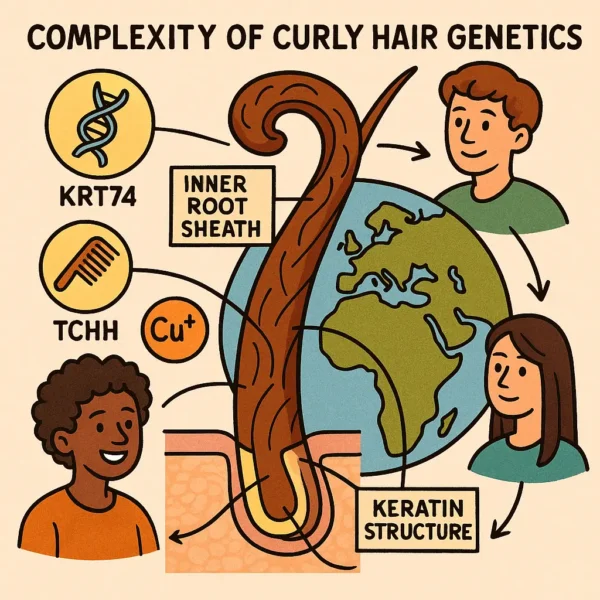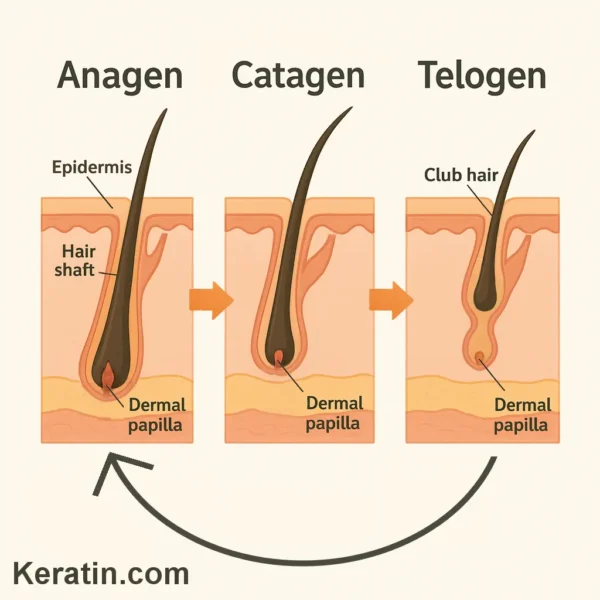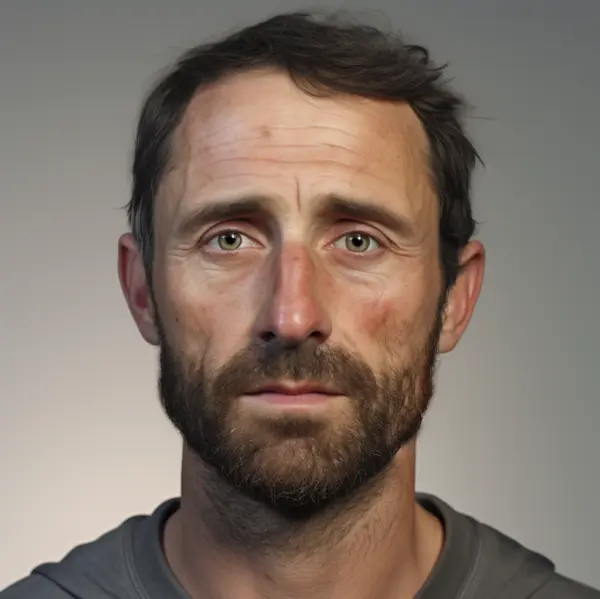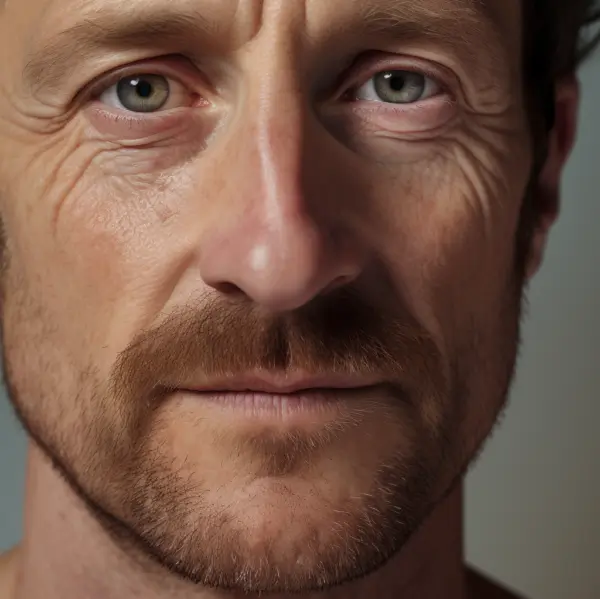Introduction: Alongside its biological underpinnings, hair shape – and especially curly hair – is profoundly influenced by genetic factors. Researchers have long recognized that curly hair tends to run in families, suggesting a hereditary component. Recent advances in genome-wide association studies (GWAS) and molecular genetics have enabled more precise identification of genes linked to curly hair. Although a single gene mutation can sometimes produce dramatic effects (as in certain forms of woolly hair syndrome), in most populations curly hair is considered a “complex trait,” governed by the interplay of multiple genes with modest individual effects. This article explores the leading genetic candidates for curly hair, their known roles in follicle structure, and the population-specific variations that lead to the remarkable hair diversity observed worldwide.
Curly Hair as a Quantifiable Trait: Central to genetic research on curly hair is the ability to measure “curliness.” Scientists can collect hair samples from volunteers of diverse backgrounds and quantify traits such as:
Mean curvature (or average bending per unit length)Number of waves or coils per unit lengthPresence of kinks, crimps, or twists Such standardized metrics allow researchers to stratify individuals into groups (e.g., low vs. high curl) and search for genetic variants that significantly correlate with measured differences.
Key Genes in Curly Hair: Several genes play a role in coding for curly hair development
1. KRT74 (Keratin 74): One of the most frequently cited hair-curl genes is KRT74 , which encodes the keratin 74 protein expressed in the Huxley’s layer of the inner root sheath. Variants in KRT74 have been found in individuals with both naturally curly or “woolly” hair phenotypes, indicating that changes in keratin structure can indeed predispose a hair shaft to bend, coil, or kink more readily.
Role in IRS Molding : Because keratin 74 helps support the IRS, certain polymorphisms in KRT74 could alter the mechanical forces the IRS exerts on the nascent hair shaft, contributing to curl formation.Evidence from Rare Disorders : Certain mutations in KRT74 produce severe phenotypes (e.g., woolly hair syndrome), reinforcing the gene’s crucial role in hair shape. 2. TCHH (Trichohyalin): Trichohyalin is a multifunctional protein that stabilizes and hardens the IRS, helping it to mold the growing hair shaft. Studies have revealed that certain TCHH variants are linked to straight or curly hair in different populations (e.g., in European-ancestry populations vs. African-ancestry populations). Moreover, rare mutations in TCHH are implicated in “uncombable hair syndrome,” which often features a markedly curly or frizzy hair texture.
Mechanistic Importance : Trichohyalin undergoes enzymatic modifications (e.g., deimination by peptidyl arginine deiminase, PAD) that fine-tune its interaction with keratins, reinforcing the cylindrical (or elliptical) alignment of the hair shaft. When trichohyalin expression or modification is disrupted, the IRS scaffolding may become uneven, promoting curls. 3. CUTC (Copper Transporter): Although often overlooked in discussions of curly hair, copper homeostasis has been linked to hair fiber shape in livestock and humans alike. For instance, copper deficiency in sheep can reduce the natural crimp of wool fibers. In humans, the gene CUTC encodes a protein involved in regulating copper levels. Variations in this gene have been associated with hair curliness in a South African cohort. Moreover, a severe disorder known as Menkes disease—characterized by a systemic copper transport defect—commonly produces “kinky” hair, highlighting copper’s role in normal follicle function and shape formation.
Additional Genetic Players: Several other developmental genes have been implicated in hair morphology:
EDAR (Ectodysplasin A Receptor) : Known for its role in East Asian populations, where it influences both hair thickness and straightness. Positive selection for an EDAR variant may have conferred additional benefits related to glandular secretions and tooth shape, with straighter hair arising as a byproduct.WNT10A : A critical developmental gene involved in embryonic hair follicle development and cycling. Mutations in WNT10A can yield hair shaft anomalies, although its role in curly hair specifically appears more population-dependent.PAD Enzymes (Peptidyl Arginine Deiminases) : These enzymes modify trichohyalin to facilitate stronger interactions with keratin filaments in the IRS. While direct associations between PAD polymorphisms and curly hair are not yet fully established, their integral role in IRS differentiation points to a likely contribution. Population and Ancestral Considerations: Hair shape is correlated with ancestral lineage and geographic origin. Africans, Melanesians, and other groups living in hot climates frequently exhibit tightly curled hair. Intriguingly, these traits evolved independently in different populations—suggesting that curly hair may have conferred certain evolutionary advantages (e.g., enhanced scalp cooling) that favored its persistence. Modern genetic studies must therefore control for population stratification, since gene frequencies (and their regulatory contexts) can vary widely across ethnic groups.
South African Cohorts : A large-scale study of Sotho/Tswana, Xhosa, and Zulu volunteers revealed a wide range of curl variation even within a traditionally “curly-haired” population. This finding underscores curly hair’s polygenic nature, wherein multiple genes, each with modest effect sizes, combine to create the final hair phenotype.Admixed Populations : Admixed groups such as those in South or Central America can carry a mixture of African, European, and Native American alleles—complicating analyses but also allowing researchers to pinpoint population-specific variants. Complexity of Curly Hair Inheritance: Contrary to some early suggestions that a single Mendelian gene could fully explain curly vs. straight hair, modern evidence indicates that hair curvature is a classic polygenic trait. Although certain major genes (KRT74 , TCHH , EDAR , CUTC ) appear repeatedly in different studies, other factors likely contribute—some of which may be regulatory elements that affect how these structural genes are expressed or modified.
Additionally, epigenetic factors (e.g., chromatin remodeling across regions like the epidermal differentiation complex on chromosome 1q21) may coordinate multiple genes involved in root sheath formation. External influences—chemical hair relaxers, repeated styling, hormonal changes—can mask genetic tendencies, illustrating that gene expression can be modulated by environment or lifestyle choices.
Translational Implications: Understanding the genetics of curly hair has practical implications in fields such as:
Forensic Analysis : Predictive tests for hair morphology based on specific gene markers could aid law enforcement in identifying unknown individuals from DNA samples.Dermatology and Hair Care : Clinicians and product developers can use these insights to tailor treatments for hair loss, scalp conditions, or to design better grooming products that account for unique structural attributes of curly hair.Gene Therapy and Personalized Medicine : As research continues, potential future interventions might target the molecular pathways regulating hair shape. Although still speculative, the fast-advancing fields of CRISPR and epigenetic editing could, in principle, alter hair texture if clinically appropriate or desired. Conclusion: The genetics of curly hair offers a prime example of how complex traits emerge from a blend of multiple gene variants, developmental pathways, and environmental influences. Leading candidates like KRT74 , TCHH , and CUTC converge on a common theme: the shaping of the inner root sheath and the biochemical or biomechanical forces it exerts on the growing hair shaft. Yet the story is far from complete. Future studies – especially large-scale, multi-ethnic genome-wide association analyses – will likely unveil additional players and shed further light on how gene-by-gene and gene-by-environment interactions foster the rich variety of curly hair types observed across the globe. By integrating molecular genetics with follicle biology, we gain a deeper appreciation of the elegant mechanisms through which nature sculpts one of humanity’s most distinctive and culturally significant features.
Bibliography
11711645 {11711645:ZSL6Y8LL},{11711645:9RZ4Q9RW},{11711645:78PSS7PP},{11711645:ZQTLVRX2},{11711645:AZVGKS9J},{11711645:TNLB85WU},{11711645:FP4V8VLM},{11711645:XX9Z3UCV},{11711645:X5EZCUKL},{11711645:UFUQ6GP8},{11711645:FUQFZI8G},{11711645:CHMB3AUM},{11711645:BLB6G4NJ},{11711645:FH4J97UF},{11711645:XZP2RB42},{11711645:P9QJVLEN},{11711645:WJ7A3CVX} 1 vancouver 50 date asc 1803 https://www.keratin.com/wp-content/plugins/zotpress/ %7B%22status%22%3A%22success%22%2C%22updateneeded%22%3Afalse%2C%22instance%22%3Afalse%2C%22meta%22%3A%7B%22request_last%22%3A0%2C%22request_next%22%3A0%2C%22used_cache%22%3Atrue%7D%2C%22data%22%3A%5B%7B%22key%22%3A%22ZQTLVRX2%22%2C%22library%22%3A%7B%22id%22%3A11711645%7D%2C%22meta%22%3A%7B%22creatorSummary%22%3A%22Hutchinson%20and%20Thompson%22%2C%22parsedDate%22%3A%221997-02%22%2C%22numChildren%22%3A0%7D%2C%22bib%22%3A%22%26lt%3Bdiv%20class%3D%26quot%3Bcsl-bib-body%26quot%3B%20style%3D%26quot%3Bline-height%3A%201.35%3B%20%26quot%3B%26gt%3B%5Cn%20%20%26lt%3Bdiv%20class%3D%26quot%3Bcsl-entry%26quot%3B%20style%3D%26quot%3Bclear%3A%20left%3B%20%26quot%3B%26gt%3B%5Cn%20%20%20%20%26lt%3Bdiv%20class%3D%26quot%3Bcsl-left-margin%26quot%3B%20style%3D%26quot%3Bfloat%3A%20left%3B%20padding-right%3A%200.5em%3B%20text-align%3A%20right%3B%20width%3A%201em%3B%26quot%3B%26gt%3B1.%26lt%3B%5C%2Fdiv%26gt%3B%26lt%3Bdiv%20class%3D%26quot%3Bcsl-right-inline%26quot%3B%20style%3D%26quot%3Bmargin%3A%200%20.4em%200%201.5em%3B%26quot%3B%26gt%3BHutchinson%20PE%2C%20Thompson%20JR.%20The%20cross-sectional%20size%20and%20shape%20of%20human%20terminal%20scalp%20hair.%20Br%20J%20Dermatol.%201997%20Feb%3B136%282%29%3A159%26%23x2013%3B65.%26lt%3B%5C%2Fdiv%26gt%3B%5Cn%20%20%20%26lt%3B%5C%2Fdiv%26gt%3B%5Cn%26lt%3B%5C%2Fdiv%26gt%3B%22%2C%22data%22%3A%7B%22itemType%22%3A%22journalArticle%22%2C%22title%22%3A%22The%20cross-sectional%20size%20and%20shape%20of%20human%20terminal%20scalp%20hair%22%2C%22creators%22%3A%5B%7B%22creatorType%22%3A%22author%22%2C%22firstName%22%3A%22P.%20E.%22%2C%22lastName%22%3A%22Hutchinson%22%7D%2C%7B%22creatorType%22%3A%22author%22%2C%22firstName%22%3A%22J.%20R.%22%2C%22lastName%22%3A%22Thompson%22%7D%5D%2C%22abstractNote%22%3A%22Change%20in%20size%20of%20the%20hair%20shaft%20with%20distance%20form%20the%20scalp%20has%20been%20investigated%2C%20using%20a%20rotatory%20profile%20method%20of%20diameter%20measurement%2C%20in%20terminal%20human%20scalp%20hair%20of%20long-haired%20young%20Caucasian%20women.%20As%20the%20whole%20length%20of%20hairs%20having%20completed%20anagen%20are%20rarely%20found%20intact%2C%20two%20types%20of%20hair%20were%20investigated%3A%20those%20including%20segments%20produced%20at%20the%20onset%20of%20anagen%20%28%26%23039%3Banagen%20hairs%26%23039%3B%29%2C%20and%20those%20including%20segments%20produced%20at%20the%20end%20of%20anagen%20%28%26%23039%3Btelogen%20hairs%26%23039%3B%29.%20In%20addition%2C%20a%20method%20of%20determining%20the%20cause%20of%20any%20size%20variation%20has%20been%20described%20and%20employed.%20Changes%20were%20found%20in%20the%20major%20axis%20of%20the%20hair%20cross-section%2C%20cross-sectional%20area%20and%20ellipticity%20with%20distance%20from%20the%20scalp%2C%20while%20the%20minor%20cross-sectional%20axis%20remained%20constant.%20It%20was%20established%20that%20these%20changes%20were%20the%20result%20of%20intrafollicular%20rather%20than%20extrafollicular%20mechanisms.%20Finally%2C%20a%20composite%20picture%20of%20the%20cross-sectional%20size%20and%20shape%20of%20the%20%26%23039%3Baverage%26%23039%3B%20whole%20anagen%20hair%20of%20the%20study%20has%20been%20constructed.%20From%20the%20distal%20tip%20towards%20the%20scalp%20for%20approximately%206-8%20cm%2C%20there%20was%20an%20abrupt%20increase%20in%20size%2C%20representing%20a%20starting-up%20phase%20of%20early%20anagen.%20Following%20this%2C%20the%20hair%20was%20at%20its%20greatest%20cross-sectional%20size%20and%20ellipticity%20which%20then%20progressively%20decreased%20through%20anagen%20%2820%25%20decrease%20for%20cross-sectional%20area%20and%2013%25%20for%20ellipticity%29.%20In%20contrast%2C%20the%20minor%20axis%20of%20the%20hair%20cross-section%2C%20remained%20constant%20throughout%20anagen.%20The%20hair%20was%20not%20therefore%20a%20uniformly%20sized%20cylinder.%20It%20was%20approximately%20spear-shaped%2C%20being%20broadened%20out%20in%20one%20plane%20distally%20where%20it%20was%20more%20elliptical.%20Subsequently%20as%20anagen%20progressed%20the%20hair%20shaft%20became%20smaller%20and%20more%20circular.%22%2C%22date%22%3A%221997-02%22%2C%22language%22%3A%22eng%22%2C%22DOI%22%3A%22%22%2C%22ISSN%22%3A%220007-0963%22%2C%22url%22%3A%22%22%2C%22collections%22%3A%5B%22RC56ISVF%22%2C%22VRXTBFGU%22%5D%2C%22dateModified%22%3A%222025-01-06T17%3A24%3A29Z%22%7D%7D%2C%7B%22key%22%3A%22BLB6G4NJ%22%2C%22library%22%3A%7B%22id%22%3A11711645%7D%2C%22meta%22%3A%7B%22creatorSummary%22%3A%22Steinert%20et%20al.%22%2C%22parsedDate%22%3A%222003-10-17%22%2C%22numChildren%22%3A0%7D%2C%22bib%22%3A%22%26lt%3Bdiv%20class%3D%26quot%3Bcsl-bib-body%26quot%3B%20style%3D%26quot%3Bline-height%3A%201.35%3B%20%26quot%3B%26gt%3B%5Cn%20%20%26lt%3Bdiv%20class%3D%26quot%3Bcsl-entry%26quot%3B%20style%3D%26quot%3Bclear%3A%20left%3B%20%26quot%3B%26gt%3B%5Cn%20%20%20%20%26lt%3Bdiv%20class%3D%26quot%3Bcsl-left-margin%26quot%3B%20style%3D%26quot%3Bfloat%3A%20left%3B%20padding-right%3A%200.5em%3B%20text-align%3A%20right%3B%20width%3A%201em%3B%26quot%3B%26gt%3B1.%26lt%3B%5C%2Fdiv%26gt%3B%26lt%3Bdiv%20class%3D%26quot%3Bcsl-right-inline%26quot%3B%20style%3D%26quot%3Bmargin%3A%200%20.4em%200%201.5em%3B%26quot%3B%26gt%3BSteinert%20PM%2C%20Parry%20DAD%2C%20Marekov%20LN.%20Trichohyalin%20mechanically%20strengthens%20the%20hair%20follicle%3A%20multiple%20cross-bridging%20roles%20in%20the%20inner%20root%20shealth.%20J%20Biol%20Chem.%202003%20Oct%2017%3B278%2842%29%3A41409%26%23x2013%3B19.%26lt%3B%5C%2Fdiv%26gt%3B%5Cn%20%20%20%26lt%3B%5C%2Fdiv%26gt%3B%5Cn%26lt%3B%5C%2Fdiv%26gt%3B%22%2C%22data%22%3A%7B%22itemType%22%3A%22journalArticle%22%2C%22title%22%3A%22Trichohyalin%20mechanically%20strengthens%20the%20hair%20follicle%3A%20multiple%20cross-bridging%20roles%20in%20the%20inner%20root%20shealth%22%2C%22creators%22%3A%5B%7B%22creatorType%22%3A%22author%22%2C%22firstName%22%3A%22Peter%20M.%22%2C%22lastName%22%3A%22Steinert%22%7D%2C%7B%22creatorType%22%3A%22author%22%2C%22firstName%22%3A%22David%20A.%20D.%22%2C%22lastName%22%3A%22Parry%22%7D%2C%7B%22creatorType%22%3A%22author%22%2C%22firstName%22%3A%22Lyuben%20N.%22%2C%22lastName%22%3A%22Marekov%22%7D%5D%2C%22abstractNote%22%3A%22Trichohyalin%20is%20expressed%20in%20specialized%20epithelia%20that%20are%20unusually%20mechanically%20strong%2C%20such%20as%20the%20inner%20root%20sheath%20cells%20of%20the%20hair%20follicle.%20We%20have%20previously%20shown%20that%20trichohyalin%20is%20sequentially%20subjected%20to%20post-synthetic%20modifications%20by%20peptidylarginine%20deaminases%2C%20which%20convert%20many%20of%20its%20arginines%20to%20citrullines%2C%20and%20by%20transglutaminases%2C%20which%20introduce%20intra-%20and%20interprotein%20chain%20cross-links.%20Here%20we%20have%20characterized%20in%20detail%20the%20proteins%20to%20which%20it%20becomes%20cross-linked%20in%20vivo%20in%20the%20inner%20root%20sheath%20of%20the%20mouse%20hair%20follicle.%20We%20suggest%20that%20it%20has%20three%20principal%20roles.%20First%2C%20it%20serves%20as%20an%20interfilamentous%20matrix%20protein%20by%20becoming%20cross-linked%20both%20to%20itself%20and%20to%20the%20head%20and%20tail%20end%20domains%20of%20the%20inner%20root%20sheath%20keratin%20intermediate%20filament%20chains.%20A%20new%20antibody%20reveals%20that%20arginines%20of%20the%20tail%20domains%20of%20the%20keratins%20are%20modified%20to%20citrullines%20before%20cross-linking%2C%20which%20clarifies%20previous%20studies.%20Second%2C%20trichohyalin%20serves%20as%20a%20cross-bridging%20reinforcement%20protein%20of%20the%20cornified%20cell%20envelope%20of%20the%20inner%20root%20sheath%20cells%20by%20becoming%20cross-linked%20to%20several%20known%20or%20novel%20barrier%20proteins%2C%20including%20involucrin%2C%20small%20proline-rich%20proteins%2C%20repetin%2C%20and%20epiplakin.%20Third%2C%20it%20coordinates%20linkage%20between%20the%20keratin%20filaments%20and%20cell%20envelope%20to%20form%20a%20seamless%20continuum.%20Together%2C%20our%20new%20data%20document%20that%20trichohyalin%20is%20a%20multi-functional%20cross-bridging%20protein%20that%20functions%20in%20the%20inner%20root%20sheath%20and%20perhaps%20in%20other%20specialized%20epithelial%20tissues%20by%20conferring%20to%20and%20coordinating%20mechanical%20strength%20between%20their%20peripheral%20cell%20envelope%20barrier%20structures%20and%20their%20cytoplasmic%20keratin%20filament%20networks.%22%2C%22date%22%3A%222003-10-17%22%2C%22language%22%3A%22eng%22%2C%22DOI%22%3A%2210.1074%5C%2Fjbc.M302037200%22%2C%22ISSN%22%3A%220021-9258%22%2C%22url%22%3A%22%22%2C%22collections%22%3A%5B%22RC56ISVF%22%2C%22VRXTBFGU%22%5D%2C%22dateModified%22%3A%222025-01-06T17%3A12%3A14Z%22%7D%7D%2C%7B%22key%22%3A%22TNLB85WU%22%2C%22library%22%3A%7B%22id%22%3A11711645%7D%2C%22meta%22%3A%7B%22creatorSummary%22%3A%22Thibaut%20et%20al.%22%2C%22parsedDate%22%3A%222007-10%22%2C%22numChildren%22%3A0%7D%2C%22bib%22%3A%22%26lt%3Bdiv%20class%3D%26quot%3Bcsl-bib-body%26quot%3B%20style%3D%26quot%3Bline-height%3A%201.35%3B%20%26quot%3B%26gt%3B%5Cn%20%20%26lt%3Bdiv%20class%3D%26quot%3Bcsl-entry%26quot%3B%20style%3D%26quot%3Bclear%3A%20left%3B%20%26quot%3B%26gt%3B%5Cn%20%20%20%20%26lt%3Bdiv%20class%3D%26quot%3Bcsl-left-margin%26quot%3B%20style%3D%26quot%3Bfloat%3A%20left%3B%20padding-right%3A%200.5em%3B%20text-align%3A%20right%3B%20width%3A%201em%3B%26quot%3B%26gt%3B1.%26lt%3B%5C%2Fdiv%26gt%3B%26lt%3Bdiv%20class%3D%26quot%3Bcsl-right-inline%26quot%3B%20style%3D%26quot%3Bmargin%3A%200%20.4em%200%201.5em%3B%26quot%3B%26gt%3BThibaut%20S%2C%20Barbarat%20P%2C%20Leroy%20F%2C%20Bernard%20BA.%20Human%20hair%20keratin%20network%20and%20curvature.%20Int%20J%20Dermatol.%202007%20Oct%3B46%20Suppl%201%3A7%26%23x2013%3B10.%26lt%3B%5C%2Fdiv%26gt%3B%5Cn%20%20%20%26lt%3B%5C%2Fdiv%26gt%3B%5Cn%26lt%3B%5C%2Fdiv%26gt%3B%22%2C%22data%22%3A%7B%22itemType%22%3A%22journalArticle%22%2C%22title%22%3A%22Human%20hair%20keratin%20network%20and%20curvature%22%2C%22creators%22%3A%5B%7B%22creatorType%22%3A%22author%22%2C%22firstName%22%3A%22Sebastien%22%2C%22lastName%22%3A%22Thibaut%22%7D%2C%7B%22creatorType%22%3A%22author%22%2C%22firstName%22%3A%22Philippe%22%2C%22lastName%22%3A%22Barbarat%22%7D%2C%7B%22creatorType%22%3A%22author%22%2C%22firstName%22%3A%22Frederic%22%2C%22lastName%22%3A%22Leroy%22%7D%2C%7B%22creatorType%22%3A%22author%22%2C%22firstName%22%3A%22Bruno%20A.%22%2C%22lastName%22%3A%22Bernard%22%7D%5D%2C%22abstractNote%22%3A%22BACKGROUND%3A%20In%20human%20hair%2C%20very%20little%20is%20known%20about%20the%20substructures%20relating%20to%20the%20curl%20pattern.%20The%20interpretation%20of%20the%20macroscopic%20shape%20of%20the%20fiber%20at%20the%20molecular%20and%20cellular%20scales%20is%20still%20unclear.%5CnMETHODS%3A%20A%20comparative%20and%20multiscale%20study%20was%20carried%20out%20on%20a%20set%20of%20human%20hair%20samples%2C%20ranging%20in%20shape%20from%20straight%20to%20tightly%20curled%2C%20in%20order%20to%20investigate%20structural%20elements%20that%20might%20be%20related%20to%20hair%20curl%20pattern.%5CnRESULTS%3A%20At%20the%20macroscopic%20level%2C%20the%20frequency%20and%20amplitude%20of%20cross-sectional%20rotations%20were%20found%20to%20be%20crucial%20for%20an%20accurate%20description%20of%20curliness.%20At%20the%20cellular%20level%2C%20transmission%20electron%20microscopy%20experiments%20made%20it%20possible%20to%20confirm%20that%20macrofibril%20organization%20was%20strongly%20related%20to%20hair%20curliness.%20The%20curly%20hair%20follicles%20exhibited%20retrocurvature%2C%20independent%20of%20ethnic%20origin.%20A%20direct%20comparison%20of%20straight%20hair%20and%20curly%20hair%20highlighted%20an%20intrinsic%20asymmetry%20in%20the%20proliferative%20compartment%20that%20clearly%20extended%20above%20the%20Auber%20line%20on%20the%20convex%20side%20of%20the%20curvature.%20This%20phenomenon%20caused%20delayed%20differentiation%20of%20both%20inner%20and%20outer%20root%20sheaths.%20The%20hair%20cortex%20itself%20was%20elliptical%20and%20asymmetric%2C%20as%20evidenced%20by%20hHa8%20keratin.%20In%20curly%20hair%2C%20this%20hair%20keratin%20accumulated%20on%20the%20concave%20side%20of%20the%20curvature%2C%20whereas%2C%20in%20straight%20hair%2C%20positive%20cortical%20cells%20were%20evenly%20distributed%20throughout%20the%20circular%20fiber.%5CnCONCLUSION%3A%20The%20curly%20shape%20of%20the%20hair%20shaft%20seems%20to%20result%20from%20the%20asymmetric%20differentiation%20of%20the%20precortex.%20Hair%20fiber%20can%20thus%20be%20considered%20as%20a%20shape%20memory%20material.%22%2C%22date%22%3A%222007-10%22%2C%22language%22%3A%22eng%22%2C%22DOI%22%3A%2210.1111%5C%2Fj.1365-4632.2007.03454.x%22%2C%22ISSN%22%3A%220011-9059%22%2C%22url%22%3A%22%22%2C%22collections%22%3A%5B%22RC56ISVF%22%2C%22VRXTBFGU%22%5D%2C%22dateModified%22%3A%222025-01-06T17%3A20%3A31Z%22%7D%7D%2C%7B%22key%22%3A%229RZ4Q9RW%22%2C%22library%22%3A%7B%22id%22%3A11711645%7D%2C%22meta%22%3A%7B%22creatorSummary%22%3A%22Fujimoto%20et%20al.%22%2C%22parsedDate%22%3A%222008-03-15%22%2C%22numChildren%22%3A0%7D%2C%22bib%22%3A%22%26lt%3Bdiv%20class%3D%26quot%3Bcsl-bib-body%26quot%3B%20style%3D%26quot%3Bline-height%3A%201.35%3B%20%26quot%3B%26gt%3B%5Cn%20%20%26lt%3Bdiv%20class%3D%26quot%3Bcsl-entry%26quot%3B%20style%3D%26quot%3Bclear%3A%20left%3B%20%26quot%3B%26gt%3B%5Cn%20%20%20%20%26lt%3Bdiv%20class%3D%26quot%3Bcsl-left-margin%26quot%3B%20style%3D%26quot%3Bfloat%3A%20left%3B%20padding-right%3A%200.5em%3B%20text-align%3A%20right%3B%20width%3A%201em%3B%26quot%3B%26gt%3B1.%26lt%3B%5C%2Fdiv%26gt%3B%26lt%3Bdiv%20class%3D%26quot%3Bcsl-right-inline%26quot%3B%20style%3D%26quot%3Bmargin%3A%200%20.4em%200%201.5em%3B%26quot%3B%26gt%3BFujimoto%20A%2C%20Kimura%20R%2C%20Ohashi%20J%2C%20Omi%20K%2C%20Yuliwulandari%20R%2C%20Batubara%20L%2C%20et%20al.%20A%20scan%20for%20genetic%20determinants%20of%20human%20hair%20morphology%3A%20EDAR%20is%20associated%20with%20Asian%20hair%20thickness.%20Hum%20Mol%20Genet.%202008%20Mar%2015%3B17%286%29%3A835%26%23x2013%3B43.%26lt%3B%5C%2Fdiv%26gt%3B%5Cn%20%20%20%26lt%3B%5C%2Fdiv%26gt%3B%5Cn%26lt%3B%5C%2Fdiv%26gt%3B%22%2C%22data%22%3A%7B%22itemType%22%3A%22journalArticle%22%2C%22title%22%3A%22A%20scan%20for%20genetic%20determinants%20of%20human%20hair%20morphology%3A%20EDAR%20is%20associated%20with%20Asian%20hair%20thickness%22%2C%22creators%22%3A%5B%7B%22creatorType%22%3A%22author%22%2C%22firstName%22%3A%22Akihiro%22%2C%22lastName%22%3A%22Fujimoto%22%7D%2C%7B%22creatorType%22%3A%22author%22%2C%22firstName%22%3A%22Ryosuke%22%2C%22lastName%22%3A%22Kimura%22%7D%2C%7B%22creatorType%22%3A%22author%22%2C%22firstName%22%3A%22Jun%22%2C%22lastName%22%3A%22Ohashi%22%7D%2C%7B%22creatorType%22%3A%22author%22%2C%22firstName%22%3A%22Kazuya%22%2C%22lastName%22%3A%22Omi%22%7D%2C%7B%22creatorType%22%3A%22author%22%2C%22firstName%22%3A%22Rika%22%2C%22lastName%22%3A%22Yuliwulandari%22%7D%2C%7B%22creatorType%22%3A%22author%22%2C%22firstName%22%3A%22Lilian%22%2C%22lastName%22%3A%22Batubara%22%7D%2C%7B%22creatorType%22%3A%22author%22%2C%22firstName%22%3A%22Mohammad%20Syamsul%22%2C%22lastName%22%3A%22Mustofa%22%7D%2C%7B%22creatorType%22%3A%22author%22%2C%22firstName%22%3A%22Urai%22%2C%22lastName%22%3A%22Samakkarn%22%7D%2C%7B%22creatorType%22%3A%22author%22%2C%22firstName%22%3A%22Wannapa%22%2C%22lastName%22%3A%22Settheetham-Ishida%22%7D%2C%7B%22creatorType%22%3A%22author%22%2C%22firstName%22%3A%22Takafumi%22%2C%22lastName%22%3A%22Ishida%22%7D%2C%7B%22creatorType%22%3A%22author%22%2C%22firstName%22%3A%22Yasuyuki%22%2C%22lastName%22%3A%22Morishita%22%7D%2C%7B%22creatorType%22%3A%22author%22%2C%22firstName%22%3A%22Takuro%22%2C%22lastName%22%3A%22Furusawa%22%7D%2C%7B%22creatorType%22%3A%22author%22%2C%22firstName%22%3A%22Minato%22%2C%22lastName%22%3A%22Nakazawa%22%7D%2C%7B%22creatorType%22%3A%22author%22%2C%22firstName%22%3A%22Ryutaro%22%2C%22lastName%22%3A%22Ohtsuka%22%7D%2C%7B%22creatorType%22%3A%22author%22%2C%22firstName%22%3A%22Katsushi%22%2C%22lastName%22%3A%22Tokunaga%22%7D%5D%2C%22abstractNote%22%3A%22Hair%20morphology%20is%20one%20of%20the%20most%20differentiated%20traits%20among%20human%20populations.%20However%2C%20genetic%20backgrounds%20of%20hair%20morphological%20differences%20among%20populations%20have%20not%20been%20clarified%20yet.%20In%20addition%2C%20little%20is%20known%20about%20the%20evolutionary%20forces%20that%20have%20acted%20on%20hair%20morphology.%20To%20identify%20hair%20morphology-determining%20genes%2C%20the%20levels%20of%20local%20genetic%20differentiation%20in%20170%20genes%20that%20are%20related%20to%20hair%20morphogenesis%20were%20evaluated%20by%20using%20data%20from%20the%20International%20HapMap%20project.%20Among%20highly%20differentiated%20genes%2C%20ectodysplasin%20A%20receptor%20%28EDAR%29%20harboring%20an%20Asian-specific%20non-synonymous%20single%20nucleotide%20polymorphism%20%281540T%5C%2FC%2C%20370Val%5C%2FAla%29%20was%20identified%20as%20a%20strong%20candidate.%20Association%20studies%20between%20genotypes%20and%20hair%20morphology%20revealed%20that%20the%20Asian-specific%201540C%20allele%20is%20associated%20with%20increase%20in%20hair%20thickness.%20Reporter%20gene%20assays%20suggested%20that%201540T%5C%2FC%20affects%20the%20activity%20of%20the%20downstream%20transcription%20factor%20NF-kappaB.%20It%20was%20inferred%20from%20geographic%20distribution%20of%201540T%5C%2FC%20and%20the%20long-range%20haplotype%20test%20that%201540C%20arose%20after%20the%20divergence%20of%20Asians%20from%20Europeans%20and%20its%20frequency%20has%20rapidly%20increased%20in%20East%20Asian%20populations.%20These%20findings%20lead%20us%20to%20conclude%20that%20EDAR%20is%20a%20major%20genetic%20determinant%20of%20Asian%20hair%20thickness%20and%20the%201540C%20allele%20spread%20through%20Asian%20populations%20due%20to%20recent%20positive%20selection.%22%2C%22date%22%3A%222008-03-15%22%2C%22language%22%3A%22eng%22%2C%22DOI%22%3A%2210.1093%5C%2Fhmg%5C%2Fddm355%22%2C%22ISSN%22%3A%221460-2083%22%2C%22url%22%3A%22%22%2C%22collections%22%3A%5B%22RC56ISVF%22%5D%2C%22dateModified%22%3A%222025-02-04T15%3A14%3A57Z%22%7D%7D%2C%7B%22key%22%3A%22XZP2RB42%22%2C%22library%22%3A%7B%22id%22%3A11711645%7D%2C%22meta%22%3A%7B%22creatorSummary%22%3A%22Medland%20et%20al.%22%2C%22parsedDate%22%3A%222009-10%22%2C%22numChildren%22%3A0%7D%2C%22bib%22%3A%22%26lt%3Bdiv%20class%3D%26quot%3Bcsl-bib-body%26quot%3B%20style%3D%26quot%3Bline-height%3A%201.35%3B%20%26quot%3B%26gt%3B%5Cn%20%20%26lt%3Bdiv%20class%3D%26quot%3Bcsl-entry%26quot%3B%20style%3D%26quot%3Bclear%3A%20left%3B%20%26quot%3B%26gt%3B%5Cn%20%20%20%20%26lt%3Bdiv%20class%3D%26quot%3Bcsl-left-margin%26quot%3B%20style%3D%26quot%3Bfloat%3A%20left%3B%20padding-right%3A%200.5em%3B%20text-align%3A%20right%3B%20width%3A%201em%3B%26quot%3B%26gt%3B1.%26lt%3B%5C%2Fdiv%26gt%3B%26lt%3Bdiv%20class%3D%26quot%3Bcsl-right-inline%26quot%3B%20style%3D%26quot%3Bmargin%3A%200%20.4em%200%201.5em%3B%26quot%3B%26gt%3BMedland%20SE%2C%20Zhu%20G%2C%20Martin%20NG.%20Estimating%20the%20heritability%20of%20hair%20curliness%20in%20twins%20of%20European%20ancestry.%20Twin%20Res%20Hum%20Genet.%202009%20Oct%3B12%285%29%3A514%26%23x2013%3B8.%26lt%3B%5C%2Fdiv%26gt%3B%5Cn%20%20%20%26lt%3B%5C%2Fdiv%26gt%3B%5Cn%26lt%3B%5C%2Fdiv%26gt%3B%22%2C%22data%22%3A%7B%22itemType%22%3A%22journalArticle%22%2C%22title%22%3A%22Estimating%20the%20heritability%20of%20hair%20curliness%20in%20twins%20of%20European%20ancestry%22%2C%22creators%22%3A%5B%7B%22creatorType%22%3A%22author%22%2C%22firstName%22%3A%22Sarah%20E.%22%2C%22lastName%22%3A%22Medland%22%7D%2C%7B%22creatorType%22%3A%22author%22%2C%22firstName%22%3A%22Gu%22%2C%22lastName%22%3A%22Zhu%22%7D%2C%7B%22creatorType%22%3A%22author%22%2C%22firstName%22%3A%22Nicholas%20G.%22%2C%22lastName%22%3A%22Martin%22%7D%5D%2C%22abstractNote%22%3A%22Recent%20studies%20in%20Asian%20populations%20have%20identified%20variants%20in%20the%20EDAR%20and%20FGFR2%20genes%20that%20arose%20following%20the%20divergence%20of%20Asians%20and%20Europeans%20and%20are%20associated%20with%20thick%20straight%20hair.%20To%20date%20no%20genetic%20variants%20have%20been%20identified%20influencing%20hair%20texture%20in%20Europeans.%20In%20the%20current%20study%20we%20examined%20the%20heritability%20of%20hair%20curliness%20in%20three%20unselected%20samples%20of%20predominantly%20European%20ancestry%20%28N%28S1%29%20%3D%202717%3B%20N%28S2%29%20%3D%203904%3B%20N%28S3%29%20%3D%205079%29.%20When%20rated%20using%20a%20three%20point%20scale%20%28Straight%5C%2FWavy%5C%2FCurly%29%20males%20were%20approximately%205%25%20more%20likely%20to%20report%20straight%20hair%20than%20females%20and%20there%20were%20suggestions%20in%20the%20data%20that%20curliness%20increased%20slightly%20with%20age.%20Across%20samples%20significant%20additive%20and%20dominant%20genetic%20influences%20were%20detected%20resulting%20in%20a%20broad%20sense%20heritability%20of%2085-95%25.%20Given%20the%20magnitude%20and%20the%20specificity%20of%20the%20EDAR%20effect%20on%20hair%20morphology%20in%20Asian%20populations%20we%20are%20hopeful%20that%20future%20association%20studies%20will%20detect%20similar%20genetic%20influences%20in%20European%20populations.%22%2C%22date%22%3A%222009-10%22%2C%22language%22%3A%22eng%22%2C%22DOI%22%3A%2210.1375%5C%2Ftwin.12.5.514%22%2C%22ISSN%22%3A%221832-4274%22%2C%22url%22%3A%22%22%2C%22collections%22%3A%5B%22RC56ISVF%22%5D%2C%22dateModified%22%3A%222025-01-06T17%3A09%3A47Z%22%7D%7D%2C%7B%22key%22%3A%22P9QJVLEN%22%2C%22library%22%3A%7B%22id%22%3A11711645%7D%2C%22meta%22%3A%7B%22creatorSummary%22%3A%22Medland%20et%20al.%22%2C%22parsedDate%22%3A%222009-11%22%2C%22numChildren%22%3A0%7D%2C%22bib%22%3A%22%26lt%3Bdiv%20class%3D%26quot%3Bcsl-bib-body%26quot%3B%20style%3D%26quot%3Bline-height%3A%201.35%3B%20%26quot%3B%26gt%3B%5Cn%20%20%26lt%3Bdiv%20class%3D%26quot%3Bcsl-entry%26quot%3B%20style%3D%26quot%3Bclear%3A%20left%3B%20%26quot%3B%26gt%3B%5Cn%20%20%20%20%26lt%3Bdiv%20class%3D%26quot%3Bcsl-left-margin%26quot%3B%20style%3D%26quot%3Bfloat%3A%20left%3B%20padding-right%3A%200.5em%3B%20text-align%3A%20right%3B%20width%3A%201em%3B%26quot%3B%26gt%3B1.%26lt%3B%5C%2Fdiv%26gt%3B%26lt%3Bdiv%20class%3D%26quot%3Bcsl-right-inline%26quot%3B%20style%3D%26quot%3Bmargin%3A%200%20.4em%200%201.5em%3B%26quot%3B%26gt%3BMedland%20SE%2C%20Nyholt%20DR%2C%20Painter%20JN%2C%20McEvoy%20BP%2C%20McRae%20AF%2C%20Zhu%20G%2C%20et%20al.%20Common%20variants%20in%20the%20trichohyalin%20gene%20are%20associated%20with%20straight%20hair%20in%20Europeans.%20Am%20J%20Hum%20Genet.%202009%20Nov%3B85%285%29%3A750%26%23x2013%3B5.%26lt%3B%5C%2Fdiv%26gt%3B%5Cn%20%20%20%26lt%3B%5C%2Fdiv%26gt%3B%5Cn%26lt%3B%5C%2Fdiv%26gt%3B%22%2C%22data%22%3A%7B%22itemType%22%3A%22journalArticle%22%2C%22title%22%3A%22Common%20variants%20in%20the%20trichohyalin%20gene%20are%20associated%20with%20straight%20hair%20in%20Europeans%22%2C%22creators%22%3A%5B%7B%22creatorType%22%3A%22author%22%2C%22firstName%22%3A%22Sarah%20E.%22%2C%22lastName%22%3A%22Medland%22%7D%2C%7B%22creatorType%22%3A%22author%22%2C%22firstName%22%3A%22Dale%20R.%22%2C%22lastName%22%3A%22Nyholt%22%7D%2C%7B%22creatorType%22%3A%22author%22%2C%22firstName%22%3A%22Jodie%20N.%22%2C%22lastName%22%3A%22Painter%22%7D%2C%7B%22creatorType%22%3A%22author%22%2C%22firstName%22%3A%22Brian%20P.%22%2C%22lastName%22%3A%22McEvoy%22%7D%2C%7B%22creatorType%22%3A%22author%22%2C%22firstName%22%3A%22Allan%20F.%22%2C%22lastName%22%3A%22McRae%22%7D%2C%7B%22creatorType%22%3A%22author%22%2C%22firstName%22%3A%22Gu%22%2C%22lastName%22%3A%22Zhu%22%7D%2C%7B%22creatorType%22%3A%22author%22%2C%22firstName%22%3A%22Scott%20D.%22%2C%22lastName%22%3A%22Gordon%22%7D%2C%7B%22creatorType%22%3A%22author%22%2C%22firstName%22%3A%22Manuel%20A.%20R.%22%2C%22lastName%22%3A%22Ferreira%22%7D%2C%7B%22creatorType%22%3A%22author%22%2C%22firstName%22%3A%22Margaret%20J.%22%2C%22lastName%22%3A%22Wright%22%7D%2C%7B%22creatorType%22%3A%22author%22%2C%22firstName%22%3A%22Anjali%20K.%22%2C%22lastName%22%3A%22Henders%22%7D%2C%7B%22creatorType%22%3A%22author%22%2C%22firstName%22%3A%22Megan%20J.%22%2C%22lastName%22%3A%22Campbell%22%7D%2C%7B%22creatorType%22%3A%22author%22%2C%22firstName%22%3A%22David%20L.%22%2C%22lastName%22%3A%22Duffy%22%7D%2C%7B%22creatorType%22%3A%22author%22%2C%22firstName%22%3A%22Narelle%20K.%22%2C%22lastName%22%3A%22Hansell%22%7D%2C%7B%22creatorType%22%3A%22author%22%2C%22firstName%22%3A%22Stuart%22%2C%22lastName%22%3A%22Macgregor%22%7D%2C%7B%22creatorType%22%3A%22author%22%2C%22firstName%22%3A%22Wendy%20S.%22%2C%22lastName%22%3A%22Slutske%22%7D%2C%7B%22creatorType%22%3A%22author%22%2C%22firstName%22%3A%22Andrew%20C.%22%2C%22lastName%22%3A%22Heath%22%7D%2C%7B%22creatorType%22%3A%22author%22%2C%22firstName%22%3A%22Grant%20W.%22%2C%22lastName%22%3A%22Montgomery%22%7D%2C%7B%22creatorType%22%3A%22author%22%2C%22firstName%22%3A%22Nicholas%20G.%22%2C%22lastName%22%3A%22Martin%22%7D%5D%2C%22abstractNote%22%3A%22Hair%20morphology%20is%20highly%20differentiated%20between%20populations%20and%20among%20people%20of%20European%20ancestry.%20Whereas%20hair%20morphology%20in%20East%20Asian%20populations%20has%20been%20studied%20extensively%2C%20relatively%20little%20is%20known%20about%20the%20genetics%20of%20this%20trait%20in%20Europeans.%20We%20performed%20a%20genome-wide%20association%20scan%20for%20hair%20morphology%20%28straight%2C%20wavy%2C%20curly%29%20in%20three%20Australian%20samples%20of%20European%20descent.%20All%20three%20samples%20showed%20evidence%20of%20association%20implicating%20the%20Trichohyalin%20gene%20%28TCHH%29%2C%20which%20is%20expressed%20in%20the%20developing%20inner%20root%20sheath%20of%20the%20hair%20follicle%2C%20and%20explaining%20approximately%206%25%20of%20variance%20%28p%3D1.5x10%28-31%29%29.%20These%20variants%20are%20at%20their%20highest%20frequency%20in%20Northern%20Europeans%2C%20paralleling%20the%20distribution%20of%20the%20straight-hair%20EDAR%20variant%20in%20Asian%20populations.%22%2C%22date%22%3A%222009-11%22%2C%22language%22%3A%22eng%22%2C%22DOI%22%3A%2210.1016%5C%2Fj.ajhg.2009.10.009%22%2C%22ISSN%22%3A%221537-6605%22%2C%22url%22%3A%22%22%2C%22collections%22%3A%5B%22RC56ISVF%22%5D%2C%22dateModified%22%3A%222025-01-06T17%3A08%3A35Z%22%7D%7D%2C%7B%22key%22%3A%22AZVGKS9J%22%2C%22library%22%3A%7B%22id%22%3A11711645%7D%2C%22meta%22%3A%7B%22creatorSummary%22%3A%22Xu%20and%20Chen%22%2C%22parsedDate%22%3A%222011-02%22%2C%22numChildren%22%3A0%7D%2C%22bib%22%3A%22%26lt%3Bdiv%20class%3D%26quot%3Bcsl-bib-body%26quot%3B%20style%3D%26quot%3Bline-height%3A%201.35%3B%20%26quot%3B%26gt%3B%5Cn%20%20%26lt%3Bdiv%20class%3D%26quot%3Bcsl-entry%26quot%3B%20style%3D%26quot%3Bclear%3A%20left%3B%20%26quot%3B%26gt%3B%5Cn%20%20%20%20%26lt%3Bdiv%20class%3D%26quot%3Bcsl-left-margin%26quot%3B%20style%3D%26quot%3Bfloat%3A%20left%3B%20padding-right%3A%200.5em%3B%20text-align%3A%20right%3B%20width%3A%201em%3B%26quot%3B%26gt%3B1.%26lt%3B%5C%2Fdiv%26gt%3B%26lt%3Bdiv%20class%3D%26quot%3Bcsl-right-inline%26quot%3B%20style%3D%26quot%3Bmargin%3A%200%20.4em%200%201.5em%3B%26quot%3B%26gt%3BXu%20B%2C%20Chen%20X.%20The%20role%20of%20mechanical%20stress%20on%20the%20formation%20of%20a%20curly%20pattern%20of%20human%20hair.%20J%20Mech%20Behav%20Biomed%20Mater.%202011%20Feb%3B4%282%29%3A212%26%23x2013%3B21.%26lt%3B%5C%2Fdiv%26gt%3B%5Cn%20%20%20%26lt%3B%5C%2Fdiv%26gt%3B%5Cn%26lt%3B%5C%2Fdiv%26gt%3B%22%2C%22data%22%3A%7B%22itemType%22%3A%22journalArticle%22%2C%22title%22%3A%22The%20role%20of%20mechanical%20stress%20on%20the%20formation%20of%20a%20curly%20pattern%20of%20human%20hair%22%2C%22creators%22%3A%5B%7B%22creatorType%22%3A%22author%22%2C%22firstName%22%3A%22Baoxing%22%2C%22lastName%22%3A%22Xu%22%7D%2C%7B%22creatorType%22%3A%22author%22%2C%22firstName%22%3A%22Xi%22%2C%22lastName%22%3A%22Chen%22%7D%5D%2C%22abstractNote%22%3A%22Understanding%20the%20factors%20that%20contribute%20to%20the%20curly%20morphology%20of%20human%20hair%20is%20important%20for%20anthropological%20and%20physiological%20studies.%20In%20the%20present%20study%2C%20the%20possible%20role%20of%20mechanical%20stress%20on%20the%20formation%20and%20selection%20of%20such%20a%20curly%20pattern%20of%20hair%20is%20explored.%20Based%20on%20the%20model%20of%20hair%20curling%20upon%20being%20squeezed%20through%20pinched%20nails%2C%20it%20is%20found%20that%20different%20levels%20and%20configurations%20of%20external%20forces%20could%20lead%20to%20the%20variation%20of%20residual%20strains%2C%20which%20in%20turn%2C%20is%20related%20to%20the%20two-dimensional%20%282D%29%20and%20three-dimensional%20%283D%29%20spatial%20hair%20curvatures.%20The%20mechanical%20principles%20are%20readily%20applicable%20to%20hair%20curling%20geometry%20due%20to%20the%20growth%20force%20exerted%20by%20hair%20follicles.%20The%20key%20mechanical%20parameters%20controlling%20the%20formation%20of%20a%20curly%20pattern%20of%20hair%2C%20as%20well%20as%20the%20key%20geometrical%20shape%20factors%20characterizing%20the%20hair%20morphology%2C%20are%20identified%20and%20correlated.%20The%20results%20obtained%20from%20the%20mechanical%20model%20are%20qualitatively%20consistent%20with%20those%20of%20previous%20experiments%20and%20observations.%22%2C%22date%22%3A%222011-02%22%2C%22language%22%3A%22eng%22%2C%22DOI%22%3A%2210.1016%5C%2Fj.jmbbm.2010.06.009%22%2C%22ISSN%22%3A%221878-0180%22%2C%22url%22%3A%22%22%2C%22collections%22%3A%5B%22RC56ISVF%22%2C%22VRXTBFGU%22%5D%2C%22dateModified%22%3A%222025-01-06T17%3A21%3A02Z%22%7D%7D%2C%7B%22key%22%3A%22FH4J97UF%22%2C%22library%22%3A%7B%22id%22%3A11711645%7D%2C%22meta%22%3A%7B%22creatorSummary%22%3A%22Westgate%20et%20al.%22%2C%22parsedDate%22%3A%222013-08%22%2C%22numChildren%22%3A0%7D%2C%22bib%22%3A%22%26lt%3Bdiv%20class%3D%26quot%3Bcsl-bib-body%26quot%3B%20style%3D%26quot%3Bline-height%3A%201.35%3B%20%26quot%3B%26gt%3B%5Cn%20%20%26lt%3Bdiv%20class%3D%26quot%3Bcsl-entry%26quot%3B%20style%3D%26quot%3Bclear%3A%20left%3B%20%26quot%3B%26gt%3B%5Cn%20%20%20%20%26lt%3Bdiv%20class%3D%26quot%3Bcsl-left-margin%26quot%3B%20style%3D%26quot%3Bfloat%3A%20left%3B%20padding-right%3A%200.5em%3B%20text-align%3A%20right%3B%20width%3A%201em%3B%26quot%3B%26gt%3B1.%26lt%3B%5C%2Fdiv%26gt%3B%26lt%3Bdiv%20class%3D%26quot%3Bcsl-right-inline%26quot%3B%20style%3D%26quot%3Bmargin%3A%200%20.4em%200%201.5em%3B%26quot%3B%26gt%3BWestgate%20GE%2C%20Botchkareva%20NV%2C%20Tobin%20DJ.%20The%20biology%20of%20hair%20diversity.%20Int%20J%20Cosmet%20Sci.%202013%20Aug%3B35%284%29%3A329%26%23x2013%3B36.%26lt%3B%5C%2Fdiv%26gt%3B%5Cn%20%20%20%26lt%3B%5C%2Fdiv%26gt%3B%5Cn%26lt%3B%5C%2Fdiv%26gt%3B%22%2C%22data%22%3A%7B%22itemType%22%3A%22journalArticle%22%2C%22title%22%3A%22The%20biology%20of%20hair%20diversity%22%2C%22creators%22%3A%5B%7B%22creatorType%22%3A%22author%22%2C%22firstName%22%3A%22Gillian%20E.%22%2C%22lastName%22%3A%22Westgate%22%7D%2C%7B%22creatorType%22%3A%22author%22%2C%22firstName%22%3A%22Natalia%20V.%22%2C%22lastName%22%3A%22Botchkareva%22%7D%2C%7B%22creatorType%22%3A%22author%22%2C%22firstName%22%3A%22Desmond%20J.%22%2C%22lastName%22%3A%22Tobin%22%7D%5D%2C%22abstractNote%22%3A%22Hair%20diversity%2C%20its%20style%2C%20colour%2C%20shape%20and%20growth%20pattern%20is%20one%20of%20our%20most%20defining%20characteristics.%20The%20natural%20versus%20temporary%20style%20is%20influenced%20by%20what%20happens%20to%20our%20hair%20during%20our%20lifetime%2C%20such%20as%20genetic%20hair%20loss%2C%20sudden%20hair%20shedding%2C%20greying%20and%20pathological%20hair%20loss%20in%20the%20various%20forms%20of%20alopecia%20because%20of%20genetics%2C%20illness%20or%20medication.%20Despite%20the%20size%20and%20global%20value%20of%20the%20hair%20care%20market%2C%20our%20knowledge%20of%20what%20controls%20the%20innate%20and%20within-lifetime%20characteristics%20of%20hair%20diversity%20remains%20poorly%20understood.%20In%20the%20last%20decade%2C%20drivers%20of%20knowledge%20have%20moved%20into%20the%20arena%20of%20genetics%20where%20hair%20traits%20are%20obvious%20and%20measurable%20and%20genetic%20polymorphisms%20are%20being%20found%20that%20raise%20valuable%20questions%20about%20the%20biology%20of%20hair%20growth.%20The%20recent%20discovery%20that%20the%20gene%20for%20trichohyalin%20contributes%20to%20hair%20shape%20comes%20as%20no%20surprise%20to%20the%20hair%20biologists%20who%20have%20believed%20for%20100%5Cu00a0years%20that%20hair%20shape%20is%20linked%20to%20the%20structure%20and%20function%20of%20the%20inner%20root%20sheath.%20Further%20conundrums%20awaiting%20elucidation%20include%20the%20polymorphisms%20in%20the%20androgen%20receptor%20%28AR%29%20described%20in%20male%20pattern%20alopecia%20whose%20location%20on%20the%20X%20chromosome%20places%20this%20genetic%20contributor%20into%20the%20female%20line.%20The%20genetics%20of%20female%20hair%20loss%20is%20less%20clear%20with%20polymorphisms%20in%20the%20AR%20not%20associated%20with%20female%20pattern%20hair%20loss.%20Lifestyle%20choices%20are%20also%20implicated%20in%20hair%20diversity.%20Greying%2C%20which%20also%20has%20a%20strong%20genetic%20component%2C%20is%20often%20suggested%20to%20have%20a%20lifestyle%20%28stress%29%20influence%20and%20hair%20follicle%20melanocytes%20show%20declining%20antioxidant%20protection%20with%20age%20and%20lowered%20resistance%20to%20stress.%20It%20is%20likely%20that%20hair%20research%20will%20undergo%20a%20renaissance%20on%20the%20back%20of%20the%20rising%20information%20from%20genetic%20studies%20as%20well%20as%20the%20latest%20contributions%20from%20the%20field%20of%20epigenetics.%22%2C%22date%22%3A%222013-08%22%2C%22language%22%3A%22eng%22%2C%22DOI%22%3A%2210.1111%5C%2Fics.12041%22%2C%22ISSN%22%3A%221468-2494%22%2C%22url%22%3A%22%22%2C%22collections%22%3A%5B%22RC56ISVF%22%2C%22VRXTBFGU%22%5D%2C%22dateModified%22%3A%222025-01-06T17%3A11%3A39Z%22%7D%7D%2C%7B%22key%22%3A%22ZSL6Y8LL%22%2C%22library%22%3A%7B%22id%22%3A11711645%7D%2C%22meta%22%3A%7B%22creatorSummary%22%3A%22Adhikari%20et%20al.%22%2C%22parsedDate%22%3A%222016-03-01%22%2C%22numChildren%22%3A0%7D%2C%22bib%22%3A%22%26lt%3Bdiv%20class%3D%26quot%3Bcsl-bib-body%26quot%3B%20style%3D%26quot%3Bline-height%3A%201.35%3B%20%26quot%3B%26gt%3B%5Cn%20%20%26lt%3Bdiv%20class%3D%26quot%3Bcsl-entry%26quot%3B%20style%3D%26quot%3Bclear%3A%20left%3B%20%26quot%3B%26gt%3B%5Cn%20%20%20%20%26lt%3Bdiv%20class%3D%26quot%3Bcsl-left-margin%26quot%3B%20style%3D%26quot%3Bfloat%3A%20left%3B%20padding-right%3A%200.5em%3B%20text-align%3A%20right%3B%20width%3A%201em%3B%26quot%3B%26gt%3B1.%26lt%3B%5C%2Fdiv%26gt%3B%26lt%3Bdiv%20class%3D%26quot%3Bcsl-right-inline%26quot%3B%20style%3D%26quot%3Bmargin%3A%200%20.4em%200%201.5em%3B%26quot%3B%26gt%3BAdhikari%20K%2C%20Fontanil%20T%2C%20Cal%20S%2C%20Mendoza-Revilla%20J%2C%20Fuentes-Guajardo%20M%2C%20Chac%26%23xF3%3Bn-Duque%20JC%2C%20et%20al.%20A%20genome-wide%20association%20scan%20in%20admixed%20Latin%20Americans%20identifies%20loci%20influencing%20facial%20and%20scalp%20hair%20features.%20Nat%20Commun.%202016%20Mar%201%3B7%281%29%3A10815.%26lt%3B%5C%2Fdiv%26gt%3B%5Cn%20%20%20%26lt%3B%5C%2Fdiv%26gt%3B%5Cn%26lt%3B%5C%2Fdiv%26gt%3B%22%2C%22data%22%3A%7B%22itemType%22%3A%22journalArticle%22%2C%22title%22%3A%22A%20genome-wide%20association%20scan%20in%20admixed%20Latin%20Americans%20identifies%20loci%20influencing%20facial%20and%20scalp%20hair%20features%22%2C%22creators%22%3A%5B%7B%22creatorType%22%3A%22author%22%2C%22firstName%22%3A%22Kaustubh%22%2C%22lastName%22%3A%22Adhikari%22%7D%2C%7B%22creatorType%22%3A%22author%22%2C%22firstName%22%3A%22Tania%22%2C%22lastName%22%3A%22Fontanil%22%7D%2C%7B%22creatorType%22%3A%22author%22%2C%22firstName%22%3A%22Santiago%22%2C%22lastName%22%3A%22Cal%22%7D%2C%7B%22creatorType%22%3A%22author%22%2C%22firstName%22%3A%22Javier%22%2C%22lastName%22%3A%22Mendoza-Revilla%22%7D%2C%7B%22creatorType%22%3A%22author%22%2C%22firstName%22%3A%22Macarena%22%2C%22lastName%22%3A%22Fuentes-Guajardo%22%7D%2C%7B%22creatorType%22%3A%22author%22%2C%22firstName%22%3A%22Juan-Camilo%22%2C%22lastName%22%3A%22Chac%5Cu00f3n-Duque%22%7D%2C%7B%22creatorType%22%3A%22author%22%2C%22firstName%22%3A%22Farah%22%2C%22lastName%22%3A%22Al-Saadi%22%7D%2C%7B%22creatorType%22%3A%22author%22%2C%22firstName%22%3A%22Jeanette%20A.%22%2C%22lastName%22%3A%22Johansson%22%7D%2C%7B%22creatorType%22%3A%22author%22%2C%22firstName%22%3A%22Mirsha%22%2C%22lastName%22%3A%22Quinto-Sanchez%22%7D%2C%7B%22creatorType%22%3A%22author%22%2C%22firstName%22%3A%22Victor%22%2C%22lastName%22%3A%22Acu%5Cu00f1a-Alonzo%22%7D%2C%7B%22creatorType%22%3A%22author%22%2C%22firstName%22%3A%22Claudia%22%2C%22lastName%22%3A%22Jaramillo%22%7D%2C%7B%22creatorType%22%3A%22author%22%2C%22firstName%22%3A%22William%22%2C%22lastName%22%3A%22Arias%22%7D%2C%7B%22creatorType%22%3A%22author%22%2C%22firstName%22%3A%22Rodrigo%22%2C%22lastName%22%3A%22Barquera%20Lozano%22%7D%2C%7B%22creatorType%22%3A%22author%22%2C%22firstName%22%3A%22Gast%5Cu00f3n%22%2C%22lastName%22%3A%22Mac%5Cu00edn%20P%5Cu00e9rez%22%7D%2C%7B%22creatorType%22%3A%22author%22%2C%22firstName%22%3A%22Jorge%22%2C%22lastName%22%3A%22G%5Cu00f3mez-Vald%5Cu00e9s%22%7D%2C%7B%22creatorType%22%3A%22author%22%2C%22firstName%22%3A%22Hugo%22%2C%22lastName%22%3A%22Villamil-Ram%5Cu00edrez%22%7D%2C%7B%22creatorType%22%3A%22author%22%2C%22firstName%22%3A%22T%5Cu00e1bita%22%2C%22lastName%22%3A%22Hunemeier%22%7D%2C%7B%22creatorType%22%3A%22author%22%2C%22firstName%22%3A%22Virginia%22%2C%22lastName%22%3A%22Ramallo%22%7D%2C%7B%22creatorType%22%3A%22author%22%2C%22firstName%22%3A%22Caio%20C.%22%2C%22lastName%22%3A%22Silva%20de%20Cerqueira%22%7D%2C%7B%22creatorType%22%3A%22author%22%2C%22firstName%22%3A%22Malena%22%2C%22lastName%22%3A%22Hurtado%22%7D%2C%7B%22creatorType%22%3A%22author%22%2C%22firstName%22%3A%22Valeria%22%2C%22lastName%22%3A%22Villegas%22%7D%2C%7B%22creatorType%22%3A%22author%22%2C%22firstName%22%3A%22Vanessa%22%2C%22lastName%22%3A%22Granja%22%7D%2C%7B%22creatorType%22%3A%22author%22%2C%22firstName%22%3A%22Carla%22%2C%22lastName%22%3A%22Gallo%22%7D%2C%7B%22creatorType%22%3A%22author%22%2C%22firstName%22%3A%22Giovanni%22%2C%22lastName%22%3A%22Poletti%22%7D%2C%7B%22creatorType%22%3A%22author%22%2C%22firstName%22%3A%22Lavinia%22%2C%22lastName%22%3A%22Schuler-Faccini%22%7D%2C%7B%22creatorType%22%3A%22author%22%2C%22firstName%22%3A%22Francisco%20M.%22%2C%22lastName%22%3A%22Salzano%22%7D%2C%7B%22creatorType%22%3A%22author%22%2C%22firstName%22%3A%22Maria-C%5Cu00e1tira%22%2C%22lastName%22%3A%22Bortolini%22%7D%2C%7B%22creatorType%22%3A%22author%22%2C%22firstName%22%3A%22Samuel%22%2C%22lastName%22%3A%22Canizales-Quinteros%22%7D%2C%7B%22creatorType%22%3A%22author%22%2C%22firstName%22%3A%22Francisco%22%2C%22lastName%22%3A%22Rothhammer%22%7D%2C%7B%22creatorType%22%3A%22author%22%2C%22firstName%22%3A%22Gabriel%22%2C%22lastName%22%3A%22Bedoya%22%7D%2C%7B%22creatorType%22%3A%22author%22%2C%22firstName%22%3A%22Rolando%22%2C%22lastName%22%3A%22Gonzalez-Jos%5Cu00e9%22%7D%2C%7B%22creatorType%22%3A%22author%22%2C%22firstName%22%3A%22Denis%22%2C%22lastName%22%3A%22Headon%22%7D%2C%7B%22creatorType%22%3A%22author%22%2C%22firstName%22%3A%22Carlos%22%2C%22lastName%22%3A%22L%5Cu00f3pez-Ot%5Cu00edn%22%7D%2C%7B%22creatorType%22%3A%22author%22%2C%22firstName%22%3A%22Desmond%20J.%22%2C%22lastName%22%3A%22Tobin%22%7D%2C%7B%22creatorType%22%3A%22author%22%2C%22firstName%22%3A%22David%22%2C%22lastName%22%3A%22Balding%22%7D%2C%7B%22creatorType%22%3A%22author%22%2C%22firstName%22%3A%22Andr%5Cu00e9s%22%2C%22lastName%22%3A%22Ruiz-Linares%22%7D%5D%2C%22abstractNote%22%3A%22We%20report%20a%20genome-wide%20association%20scan%20in%20over%206%2C000%20Latin%20Americans%20for%20features%20of%20scalp%20hair%20%28shape%2C%20colour%2C%20greying%2C%20balding%29%20and%20facial%20hair%20%28beard%20thickness%2C%20monobrow%2C%20eyebrow%20thickness%29.%20We%20found%2018%20signals%20of%20association%20reaching%20genome-wide%20significance%20%28P%20values%205%20%5Cu00d7%2010%5Cu22128%20to%203%20%5Cu00d7%2010%5Cu2212119%29%2C%20including%2010%20novel%20associations.%20These%20include%20novel%20loci%20for%20scalp%20hair%20shape%20and%20balding%2C%20and%20the%20first%20reported%20loci%20for%20hair%20greying%2C%20monobrow%2C%20eyebrow%20and%20beard%20thickness.%20A%20newly%20identified%20locus%20influencing%20hair%20shape%20includes%20a%20Q30R%20substitution%20in%20the%20Protease%20Serine%20S1%20family%20member%2053%20%28PRSS53%29.%20We%20demonstrate%20that%20this%20enzyme%20is%20highly%20expressed%20in%20the%20hair%20follicle%2C%20especially%20the%20inner%20root%20sheath%2C%20and%20that%20the%20Q30R%20substitution%20affects%20enzyme%20processing%20and%20secretion.%20The%20genome%20regions%20associated%20with%20hair%20features%20are%20enriched%20for%20signals%20of%20selection%2C%20consistent%20with%20proposals%20regarding%20the%20evolution%20of%20human%20hair.%22%2C%22date%22%3A%222016-03-01%22%2C%22language%22%3A%22en%22%2C%22DOI%22%3A%2210.1038%5C%2Fncomms10815%22%2C%22ISSN%22%3A%222041-1723%22%2C%22url%22%3A%22%22%2C%22collections%22%3A%5B%22RC56ISVF%22%5D%2C%22dateModified%22%3A%222025-04-15T16%3A21%3A22Z%22%7D%7D%2C%7B%22key%22%3A%22WJ7A3CVX%22%2C%22library%22%3A%7B%22id%22%3A11711645%7D%2C%22meta%22%3A%7B%22creatorSummary%22%3A%22Westgate%20et%20al.%22%2C%22parsedDate%22%3A%222017-06%22%2C%22numChildren%22%3A0%7D%2C%22bib%22%3A%22%26lt%3Bdiv%20class%3D%26quot%3Bcsl-bib-body%26quot%3B%20style%3D%26quot%3Bline-height%3A%201.35%3B%20%26quot%3B%26gt%3B%5Cn%20%20%26lt%3Bdiv%20class%3D%26quot%3Bcsl-entry%26quot%3B%20style%3D%26quot%3Bclear%3A%20left%3B%20%26quot%3B%26gt%3B%5Cn%20%20%20%20%26lt%3Bdiv%20class%3D%26quot%3Bcsl-left-margin%26quot%3B%20style%3D%26quot%3Bfloat%3A%20left%3B%20padding-right%3A%200.5em%3B%20text-align%3A%20right%3B%20width%3A%201em%3B%26quot%3B%26gt%3B1.%26lt%3B%5C%2Fdiv%26gt%3B%26lt%3Bdiv%20class%3D%26quot%3Bcsl-right-inline%26quot%3B%20style%3D%26quot%3Bmargin%3A%200%20.4em%200%201.5em%3B%26quot%3B%26gt%3BWestgate%20GE%2C%20Ginger%20RS%2C%20Green%20MR.%20The%20biology%20and%20genetics%20of%20curly%20hair.%20Exp%20Dermatol.%202017%20June%3B26%286%29%3A483%26%23x2013%3B90.%26lt%3B%5C%2Fdiv%26gt%3B%5Cn%20%20%20%26lt%3B%5C%2Fdiv%26gt%3B%5Cn%26lt%3B%5C%2Fdiv%26gt%3B%22%2C%22data%22%3A%7B%22itemType%22%3A%22journalArticle%22%2C%22title%22%3A%22The%20biology%20and%20genetics%20of%20curly%20hair%22%2C%22creators%22%3A%5B%7B%22creatorType%22%3A%22author%22%2C%22firstName%22%3A%22Gillian%20E.%22%2C%22lastName%22%3A%22Westgate%22%7D%2C%7B%22creatorType%22%3A%22author%22%2C%22firstName%22%3A%22Rebecca%20S.%22%2C%22lastName%22%3A%22Ginger%22%7D%2C%7B%22creatorType%22%3A%22author%22%2C%22firstName%22%3A%22Martin%20R.%22%2C%22lastName%22%3A%22Green%22%7D%5D%2C%22abstractNote%22%3A%22Hair%20fibres%20show%20wide%20diversity%20across%20and%20within%20all%20human%20populations%2C%20suggesting%20that%20hair%20fibre%20form%20and%20colour%20have%20been%20subject%20to%20much%20adaptive%20pressure%20over%20thousands%20of%20years.%20All%20human%20hair%20fibres%20typically%20have%20the%20same%20basic%20structure.%20However%2C%20the%20three-dimensional%20shape%20of%20the%20entire%20fibre%20varies%20considerably%20depending%20on%20ethnicity%20and%20geography%2C%20with%20examples%20from%20very%20straight%20hair%20with%20no%20rotational%20turn%20about%20the%20long%20axis%2C%20to%20the%20tightly%20sprung%20coils%20of%20African%20races.%20The%20creation%20of%20the%20highly%20complex%20biomaterials%20in%20hair%20follicle%20and%20how%20these%20confer%20mechanical%20functions%20on%20the%20fibre%20so%20formed%20is%20a%20topic%20that%20remains%20relatively%20unexplained%20thus%20far.%20We%20review%20the%20current%20understanding%20on%20how%20hair%20fibres%20are%20formed%20into%20a%20nonlinear%20coiled%20form%20and%20which%20genetic%20and%20biological%20factors%20are%20thought%20to%20be%20responsible%20for%20hair%20shape.%20We%20report%20on%20a%20new%20GWAS%20comparing%20low%20and%20high%20curl%20individuals%20in%20South%20Africa%2C%20revealing%20strong%20links%20to%20polymorphic%20variation%20in%20trichohyalin%2C%20a%20copper%20transporter%20protein%20CUTC%20and%20the%20inner%20root%20sheath%20component%20keratin%2074.%20This%20builds%20onto%20the%20growing%20knowledge%20base%20describing%20the%20control%20of%20curly%20hair%20formation.%22%2C%22date%22%3A%222017-06%22%2C%22language%22%3A%22eng%22%2C%22DOI%22%3A%2210.1111%5C%2Fexd.13347%22%2C%22ISSN%22%3A%221600-0625%22%2C%22url%22%3A%22%22%2C%22collections%22%3A%5B%22RC56ISVF%22%2C%22VRXTBFGU%22%5D%2C%22dateModified%22%3A%222025-01-06T17%3A07%3A23Z%22%7D%7D%2C%7B%22key%22%3A%22CHMB3AUM%22%2C%22library%22%3A%7B%22id%22%3A11711645%7D%2C%22meta%22%3A%7B%22creatorSummary%22%3A%22Liu%20et%20al.%22%2C%22parsedDate%22%3A%222018-02-01%22%2C%22numChildren%22%3A0%7D%2C%22bib%22%3A%22%26lt%3Bdiv%20class%3D%26quot%3Bcsl-bib-body%26quot%3B%20style%3D%26quot%3Bline-height%3A%201.35%3B%20%26quot%3B%26gt%3B%5Cn%20%20%26lt%3Bdiv%20class%3D%26quot%3Bcsl-entry%26quot%3B%20style%3D%26quot%3Bclear%3A%20left%3B%20%26quot%3B%26gt%3B%5Cn%20%20%20%20%26lt%3Bdiv%20class%3D%26quot%3Bcsl-left-margin%26quot%3B%20style%3D%26quot%3Bfloat%3A%20left%3B%20padding-right%3A%200.5em%3B%20text-align%3A%20right%3B%20width%3A%201em%3B%26quot%3B%26gt%3B1.%26lt%3B%5C%2Fdiv%26gt%3B%26lt%3Bdiv%20class%3D%26quot%3Bcsl-right-inline%26quot%3B%20style%3D%26quot%3Bmargin%3A%200%20.4em%200%201.5em%3B%26quot%3B%26gt%3BLiu%20F%2C%20Chen%20Y%2C%20Zhu%20G%2C%20Hysi%20PG%2C%20Wu%20S%2C%20Adhikari%20K%2C%20et%20al.%20Meta-analysis%20of%20genome-wide%20association%20studies%20identifies%208%20novel%20loci%20involved%20in%20shape%20variation%20of%20human%20head%20hair.%20Hum%20Mol%20Genet.%202018%20Feb%201%3B27%283%29%3A559%26%23x2013%3B75.%26lt%3B%5C%2Fdiv%26gt%3B%5Cn%20%20%20%26lt%3B%5C%2Fdiv%26gt%3B%5Cn%26lt%3B%5C%2Fdiv%26gt%3B%22%2C%22data%22%3A%7B%22itemType%22%3A%22journalArticle%22%2C%22title%22%3A%22Meta-analysis%20of%20genome-wide%20association%20studies%20identifies%208%20novel%20loci%20involved%20in%20shape%20variation%20of%20human%20head%20hair%22%2C%22creators%22%3A%5B%7B%22creatorType%22%3A%22author%22%2C%22firstName%22%3A%22Fan%22%2C%22lastName%22%3A%22Liu%22%7D%2C%7B%22creatorType%22%3A%22author%22%2C%22firstName%22%3A%22Yan%22%2C%22lastName%22%3A%22Chen%22%7D%2C%7B%22creatorType%22%3A%22author%22%2C%22firstName%22%3A%22Gu%22%2C%22lastName%22%3A%22Zhu%22%7D%2C%7B%22creatorType%22%3A%22author%22%2C%22firstName%22%3A%22Pirro%20G.%22%2C%22lastName%22%3A%22Hysi%22%7D%2C%7B%22creatorType%22%3A%22author%22%2C%22firstName%22%3A%22Sijie%22%2C%22lastName%22%3A%22Wu%22%7D%2C%7B%22creatorType%22%3A%22author%22%2C%22firstName%22%3A%22Kaustubh%22%2C%22lastName%22%3A%22Adhikari%22%7D%2C%7B%22creatorType%22%3A%22author%22%2C%22firstName%22%3A%22Krystal%22%2C%22lastName%22%3A%22Breslin%22%7D%2C%7B%22creatorType%22%3A%22author%22%2C%22firstName%22%3A%22Ewelina%22%2C%22lastName%22%3A%22Pospiech%22%7D%2C%7B%22creatorType%22%3A%22author%22%2C%22firstName%22%3A%22Merel%20A.%22%2C%22lastName%22%3A%22Hamer%22%7D%2C%7B%22creatorType%22%3A%22author%22%2C%22firstName%22%3A%22Fuduan%22%2C%22lastName%22%3A%22Peng%22%7D%2C%7B%22creatorType%22%3A%22author%22%2C%22firstName%22%3A%22Charanya%22%2C%22lastName%22%3A%22Muralidharan%22%7D%2C%7B%22creatorType%22%3A%22author%22%2C%22firstName%22%3A%22Victor%22%2C%22lastName%22%3A%22Acuna-Alonzo%22%7D%2C%7B%22creatorType%22%3A%22author%22%2C%22firstName%22%3A%22Samuel%22%2C%22lastName%22%3A%22Canizales-Quinteros%22%7D%2C%7B%22creatorType%22%3A%22author%22%2C%22firstName%22%3A%22Gabriel%22%2C%22lastName%22%3A%22Bedoya%22%7D%2C%7B%22creatorType%22%3A%22author%22%2C%22firstName%22%3A%22Carla%22%2C%22lastName%22%3A%22Gallo%22%7D%2C%7B%22creatorType%22%3A%22author%22%2C%22firstName%22%3A%22Giovanni%22%2C%22lastName%22%3A%22Poletti%22%7D%2C%7B%22creatorType%22%3A%22author%22%2C%22firstName%22%3A%22Francisco%22%2C%22lastName%22%3A%22Rothhammer%22%7D%2C%7B%22creatorType%22%3A%22author%22%2C%22firstName%22%3A%22Maria%20Catira%22%2C%22lastName%22%3A%22Bortolini%22%7D%2C%7B%22creatorType%22%3A%22author%22%2C%22firstName%22%3A%22Rolando%22%2C%22lastName%22%3A%22Gonzalez-Jose%22%7D%2C%7B%22creatorType%22%3A%22author%22%2C%22firstName%22%3A%22Changqing%22%2C%22lastName%22%3A%22Zeng%22%7D%2C%7B%22creatorType%22%3A%22author%22%2C%22firstName%22%3A%22Shuhua%22%2C%22lastName%22%3A%22Xu%22%7D%2C%7B%22creatorType%22%3A%22author%22%2C%22firstName%22%3A%22Li%22%2C%22lastName%22%3A%22Jin%22%7D%2C%7B%22creatorType%22%3A%22author%22%2C%22firstName%22%3A%22Andr%5Cu00e9%20G.%22%2C%22lastName%22%3A%22Uitterlinden%22%7D%2C%7B%22creatorType%22%3A%22author%22%2C%22firstName%22%3A%22M.%20Arfan%22%2C%22lastName%22%3A%22Ikram%22%7D%2C%7B%22creatorType%22%3A%22author%22%2C%22firstName%22%3A%22Cornelia%20M.%22%2C%22lastName%22%3A%22van%20Duijn%22%7D%2C%7B%22creatorType%22%3A%22author%22%2C%22firstName%22%3A%22Tamar%22%2C%22lastName%22%3A%22Nijsten%22%7D%2C%7B%22creatorType%22%3A%22author%22%2C%22firstName%22%3A%22Susan%22%2C%22lastName%22%3A%22Walsh%22%7D%2C%7B%22creatorType%22%3A%22author%22%2C%22firstName%22%3A%22Wojciech%22%2C%22lastName%22%3A%22Branicki%22%7D%2C%7B%22creatorType%22%3A%22author%22%2C%22firstName%22%3A%22Sijia%22%2C%22lastName%22%3A%22Wang%22%7D%2C%7B%22creatorType%22%3A%22author%22%2C%22firstName%22%3A%22Andr%5Cu00e9s%22%2C%22lastName%22%3A%22Ruiz-Linares%22%7D%2C%7B%22creatorType%22%3A%22author%22%2C%22firstName%22%3A%22Timothy%20D.%22%2C%22lastName%22%3A%22Spector%22%7D%2C%7B%22creatorType%22%3A%22author%22%2C%22firstName%22%3A%22Nicholas%20G.%22%2C%22lastName%22%3A%22Martin%22%7D%2C%7B%22creatorType%22%3A%22author%22%2C%22firstName%22%3A%22Sarah%20E.%22%2C%22lastName%22%3A%22Medland%22%7D%2C%7B%22creatorType%22%3A%22author%22%2C%22firstName%22%3A%22Manfred%22%2C%22lastName%22%3A%22Kayser%22%7D%5D%2C%22abstractNote%22%3A%22Shape%20variation%20of%20human%20head%20hair%20shows%20striking%20variation%20within%20and%20between%20human%20populations%2C%20while%20its%20genetic%20basis%20is%20far%20from%20being%20understood.%20We%20performed%20a%20series%20of%20genome-wide%20association%20studies%20%28GWASs%29%20and%20replication%20studies%20in%20a%20total%20of%2028%20964%20subjects%20from%209%20cohorts%20from%20multiple%20geographic%20origins.%20A%20meta-analysis%20of%20three%20European%20GWASs%20identified%208%20novel%20loci%20%281p36.23%20ERRFI1%5C%2FSLC45A1%2C%201p36.22%20PEX14%2C%201p36.13%20PADI3%2C%202p13.3%20TGFA%2C%2011p14.1%20LGR4%2C%2012q13.13%20HOXC13%2C%2017q21.2%20KRTAP%2C%20and%2020q13.33%20PTK6%29%2C%20and%20confirmed%204%20previously%20known%20ones%20%281q21.3%20TCHH%5C%2FTCHHL1%5C%2FLCE3E%2C%202q35%20WNT10A%2C%204q21.21%20FRAS1%2C%20and%2010p14%20LINC00708%5C%2FGATA3%29%2C%20all%20showing%20genome-wide%20significant%20association%20with%20hair%20shape%20%28P%5Cu2009%26lt%3B%5Cu20095e-8%29.%20All%20except%20one%20%281p36.22%20PEX14%29%20were%20replicated%20with%20nominal%20significance%20in%20at%20least%20one%20of%20the%206%20additional%20cohorts%20of%20European%2C%20Native%20American%20and%20East%20Asian%20origins.%20Three%20additional%20previously%20known%20genes%20%28EDAR%2C%20OFCC1%2C%20and%20PRSS53%29%20were%20confirmed%20at%20the%20nominal%20significance%20level.%20A%20multivariable%20regression%20model%20revealed%20that%2014%20SNPs%20from%20different%20genes%20significantly%20and%20independently%20contribute%20to%20hair%20shape%20variation%2C%20reaching%20a%20cross-validated%20AUC%20value%20of%200.66%20%2895%25%20CI%3A%200.62-0.70%29%20and%20an%20AUC%20value%20of%200.64%20in%20an%20independent%20validation%20cohort%2C%20providing%20an%20improved%20accuracy%20compared%20with%20a%20previous%20model.%20Prediction%20outcomes%20of%202504%20individuals%20from%20a%20multiethnic%20sample%20were%20largely%20consistent%20with%20general%20knowledge%20on%20the%20global%20distribution%20of%20hair%20shape%20variation.%20Our%20study%20thus%20delivers%20target%20genes%20and%20DNA%20variants%20for%20future%20functional%20studies%20to%20further%20evaluate%20the%20molecular%20basis%20of%20hair%20shape%20in%20humans.%22%2C%22date%22%3A%222018-02-01%22%2C%22language%22%3A%22eng%22%2C%22DOI%22%3A%2210.1093%5C%2Fhmg%5C%2Fddx416%22%2C%22ISSN%22%3A%221460-2083%22%2C%22url%22%3A%22%22%2C%22collections%22%3A%5B%22RC56ISVF%22%5D%2C%22dateModified%22%3A%222025-01-06T17%3A12%3A52Z%22%7D%7D%2C%7B%22key%22%3A%22XX9Z3UCV%22%2C%22library%22%3A%7B%22id%22%3A11711645%7D%2C%22meta%22%3A%7B%22creatorSummary%22%3A%22Cloete%20et%20al.%22%2C%22parsedDate%22%3A%222020-01%22%2C%22numChildren%22%3A0%7D%2C%22bib%22%3A%22%26lt%3Bdiv%20class%3D%26quot%3Bcsl-bib-body%26quot%3B%20style%3D%26quot%3Bline-height%3A%201.35%3B%20%26quot%3B%26gt%3B%5Cn%20%20%26lt%3Bdiv%20class%3D%26quot%3Bcsl-entry%26quot%3B%20style%3D%26quot%3Bclear%3A%20left%3B%20%26quot%3B%26gt%3B%5Cn%20%20%20%20%26lt%3Bdiv%20class%3D%26quot%3Bcsl-left-margin%26quot%3B%20style%3D%26quot%3Bfloat%3A%20left%3B%20padding-right%3A%200.5em%3B%20text-align%3A%20right%3B%20width%3A%201em%3B%26quot%3B%26gt%3B1.%26lt%3B%5C%2Fdiv%26gt%3B%26lt%3Bdiv%20class%3D%26quot%3Bcsl-right-inline%26quot%3B%20style%3D%26quot%3Bmargin%3A%200%20.4em%200%201.5em%3B%26quot%3B%26gt%3BCloete%20E%2C%20Khumalo%20NP%2C%20Ngoepe%20MN.%20Understanding%20Curly%20Hair%20Mechanics%3A%20Fiber%26%23xA0%3BStrength.%20J%20Invest%20Dermatol.%202020%20Jan%3B140%281%29%3A113%26%23x2013%3B20.%26lt%3B%5C%2Fdiv%26gt%3B%5Cn%20%20%20%26lt%3B%5C%2Fdiv%26gt%3B%5Cn%26lt%3B%5C%2Fdiv%26gt%3B%22%2C%22data%22%3A%7B%22itemType%22%3A%22journalArticle%22%2C%22title%22%3A%22Understanding%20Curly%20Hair%20Mechanics%3A%20Fiber%5Cu00a0Strength%22%2C%22creators%22%3A%5B%7B%22creatorType%22%3A%22author%22%2C%22firstName%22%3A%22Elsabe%22%2C%22lastName%22%3A%22Cloete%22%7D%2C%7B%22creatorType%22%3A%22author%22%2C%22firstName%22%3A%22Nonhlanhla%20P.%22%2C%22lastName%22%3A%22Khumalo%22%7D%2C%7B%22creatorType%22%3A%22author%22%2C%22firstName%22%3A%22Malebogo%20N.%22%2C%22lastName%22%3A%22Ngoepe%22%7D%5D%2C%22abstractNote%22%3A%22The%20relationship%20between%20the%20geometric%20and%20mechanical%20profiles%20of%20hair%20fibers%20has%20been%20studied%2C%20with%20special%20focus%20on%20curly%20samples.%20Incidental%20observations%20pointed%20to%20a%20significantly%20different%20viscoelastic%20character%20with%20varying%20curliness.%20Further%20investigations%20confirmed%20initial%20observations%2C%20showing%20an%20initial%20distinct%20toe%20region%20behavior%20for%20curly%20fibers%20on%20the%20stress-strain%20plot%2C%20which%20is%20absent%20for%20straight%20fibers.%20This%20behavior%20suggested%20a%20difference%20in%20the%20viscoelastic%20nature%20of%20the%20curly%20fiber%20that%20is%20linked%20to%20mechanical%20energy%20stored%20in%20the%20fiber.%20Results%20also%20suggest%20that%20the%20strength%20of%20hair%20depends%20on%20two%20main%20components%2C%20and%20further%20pointed%20out%20that%20de%20facto%20methods%20of%20tensile%20testing%20may%20erode%20curly%20fiber%20strength%20during%20preparation.%20The%20main%20outcome%20of%20this%20study%20is%20that%20the%20tensile%20strength%20%28%5Cu03c3T%29%20of%20hair%20fibers%20is%20composed%20of%20two%20%28rather%20than%20one%20main%29%20components%2C%20namely%20the%20toe%20region%20%28%5Cu03c3t%29%20and%20the%20elastic%20region%20%28%5Cu03c3%5Cu03b5%29%2C%20so%20that%3A%20%5Cu03c3T%3D%5Cu03c3t%2B%5Cu03c3%5Cu03b5.%20For%20noncurly%20fibers%2C%20the%20greatest%20part%20of%20fiber%20strength%20is%20derived%20from%20%5Cu03c3%5Cu03b5%2C%20while%20%5Cu03c3t%20%5Cu2248%200.%20For%20curly%20fibers%2C%20%5Cu03c3t%20%28i.e.%2C%20springiness%29%20adds%20significantly%20to%20the%20overall%20strength%2C%20even%20though%20%5Cu03c3%5Cu03b5%20remains%20the%20major%20contributor.%20Although%20these%20results%20require%20validation%20in%20larger%20studies%2C%20they%20are%20significant%20in%20the%20current%20understanding%20of%20curly%20hair.%20Also%2C%20they%20may%20represent%20a%20fundamental%20shift%20from%20the%20current%20understanding%20of%20tensile%20testing%20of%20human%20hair%20in%20general.%22%2C%22date%22%3A%222020-01%22%2C%22language%22%3A%22eng%22%2C%22DOI%22%3A%2210.1016%5C%2Fj.jid.2019.06.141%22%2C%22ISSN%22%3A%221523-1747%22%2C%22url%22%3A%22%22%2C%22collections%22%3A%5B%22RC56ISVF%22%2C%22VRXTBFGU%22%5D%2C%22dateModified%22%3A%222025-01-06T17%3A19%3A09Z%22%7D%7D%2C%7B%22key%22%3A%22FP4V8VLM%22%2C%22library%22%3A%7B%22id%22%3A11711645%7D%2C%22meta%22%3A%7B%22creatorSummary%22%3A%22Wortmann%20et%20al.%22%2C%22parsedDate%22%3A%222020-03%22%2C%22numChildren%22%3A0%7D%2C%22bib%22%3A%22%26lt%3Bdiv%20class%3D%26quot%3Bcsl-bib-body%26quot%3B%20style%3D%26quot%3Bline-height%3A%201.35%3B%20%26quot%3B%26gt%3B%5Cn%20%20%26lt%3Bdiv%20class%3D%26quot%3Bcsl-entry%26quot%3B%20style%3D%26quot%3Bclear%3A%20left%3B%20%26quot%3B%26gt%3B%5Cn%20%20%20%20%26lt%3Bdiv%20class%3D%26quot%3Bcsl-left-margin%26quot%3B%20style%3D%26quot%3Bfloat%3A%20left%3B%20padding-right%3A%200.5em%3B%20text-align%3A%20right%3B%20width%3A%201em%3B%26quot%3B%26gt%3B1.%26lt%3B%5C%2Fdiv%26gt%3B%26lt%3Bdiv%20class%3D%26quot%3Bcsl-right-inline%26quot%3B%20style%3D%26quot%3Bmargin%3A%200%20.4em%200%201.5em%3B%26quot%3B%26gt%3BWortmann%20FJ%2C%20Wortmann%20G%2C%20Sripho%20T.%20Why%20is%20hair%20curly%3F-Deductions%20from%20the%20structure%20and%20the%20biomechanics%20of%20the%20mature%20hair%20shaft.%20Exp%20Dermatol.%202020%20Mar%3B29%283%29%3A366%26%23x2013%3B72.%26lt%3B%5C%2Fdiv%26gt%3B%5Cn%20%20%20%26lt%3B%5C%2Fdiv%26gt%3B%5Cn%26lt%3B%5C%2Fdiv%26gt%3B%22%2C%22data%22%3A%7B%22itemType%22%3A%22journalArticle%22%2C%22title%22%3A%22Why%20is%20hair%20curly%3F-Deductions%20from%20the%20structure%20and%20the%20biomechanics%20of%20the%20mature%20hair%20shaft%22%2C%22creators%22%3A%5B%7B%22creatorType%22%3A%22author%22%2C%22firstName%22%3A%22Franz%20J.%22%2C%22lastName%22%3A%22Wortmann%22%7D%2C%7B%22creatorType%22%3A%22author%22%2C%22firstName%22%3A%22Gabriele%22%2C%22lastName%22%3A%22Wortmann%22%7D%2C%7B%22creatorType%22%3A%22author%22%2C%22firstName%22%3A%22Therakanya%22%2C%22lastName%22%3A%22Sripho%22%7D%5D%2C%22abstractNote%22%3A%22The%20final%20shape%20of%20a%20head%20hair%20is%20predetermined%20through%20a%20variety%20of%20factors%20during%20its%20formation%20in%20the%20follicle.%20These%20are%20genetic%20pathways%2C%20specific%20growth%20factors%2C%20cell%20differentiation%20and%20segregation%2C%20etc%2C%20with%20spatial%20as%20well%20as%20chronological%20dynamics.%20The%20cortex%20of%20hair%20consists%20of%20two%20major%20cell%20groups.%20These%20are%20characterized%20by%20parallel%20%28para-type%29%20or%20roughly%20helical%20arrangements%20%28ortho-type%29%20of%20the%20intermediate%20filaments%20%28IF%29.%20There%20are%20also%20cell-specific%20differences%20in%20the%20disulphide%20content%2C%20that%20is%2C%20of%20the%20cross-link%20density%20of%20the%20IF-associated%20matrix%20proteins.%20Given%20the%20current%20state%20of%20the%20academic%20discussion%2C%20we%20consider%20it%20as%20timely%20to%20support%20and%20broaden%20the%20view%20that%2C%20the%20structural%20differences%20of%20the%20cell%20types%20together%20with%20their%20lateral%20segregation%20are%20the%20main%20driving%20factor%20of%20curl%20formation.%20The%20mechanical%20effects%2C%20which%20derive%20thereof%2C%20are%20triggered%20in%20the%20transition%20zone%20of%20the%20follicle%2C%20that%20is%2C%20upon%20formation%20of%20the%20mature%20hair%20shaft.%20Furthermore%2C%20an%20irregular%2C%20%26quot%3Bflat%26quot%3B%20cross%20section%20of%20the%20hair%20shaft%20is%20shown%20to%20be%20a%20synergistic%20but%20not%20determining%20factor%20of%20curl%20formation.%20The%20degree%20of%20cell%20type%20segregation%20along%20the%20mature%20hair%20shaft%20together%20with%20dynamic%20changes%20of%20the%20location%20of%20the%20plane%20of%20segregation%2C%20namely%20in%20a%20non-circular%20cross%20section%20can%20account%20for%20very%20complex%20curl%20patterns.%20Against%20the%20background%20of%20these%20views%2C%20we%20argue%20that%20contributions%20to%20hair%20curl%20are%20implausible%2C%20if%20they%20relate%20to%20physical%20mechanisms%20which%20are%20active%20below%20the%20transition%20zone%20from%20the%20living%20to%20the%20mature%20%28dead%29%20hair.%22%2C%22date%22%3A%222020-03%22%2C%22language%22%3A%22eng%22%2C%22DOI%22%3A%2210.1111%5C%2Fexd.14048%22%2C%22ISSN%22%3A%221600-0625%22%2C%22url%22%3A%22%22%2C%22collections%22%3A%5B%22RC56ISVF%22%2C%22VRXTBFGU%22%5D%2C%22dateModified%22%3A%222025-01-06T17%3A19%3A55Z%22%7D%7D%2C%7B%22key%22%3A%22UFUQ6GP8%22%2C%22library%22%3A%7B%22id%22%3A11711645%7D%2C%22meta%22%3A%7B%22creatorSummary%22%3A%22Maes%20et%20al.%22%2C%22parsedDate%22%3A%222021%22%2C%22numChildren%22%3A0%7D%2C%22bib%22%3A%22%26lt%3Bdiv%20class%3D%26quot%3Bcsl-bib-body%26quot%3B%20style%3D%26quot%3Bline-height%3A%201.35%3B%20%26quot%3B%26gt%3B%5Cn%20%20%26lt%3Bdiv%20class%3D%26quot%3Bcsl-entry%26quot%3B%20style%3D%26quot%3Bclear%3A%20left%3B%20%26quot%3B%26gt%3B%5Cn%20%20%20%20%26lt%3Bdiv%20class%3D%26quot%3Bcsl-left-margin%26quot%3B%20style%3D%26quot%3Bfloat%3A%20left%3B%20padding-right%3A%200.5em%3B%20text-align%3A%20right%3B%20width%3A%201em%3B%26quot%3B%26gt%3B1.%26lt%3B%5C%2Fdiv%26gt%3B%26lt%3Bdiv%20class%3D%26quot%3Bcsl-right-inline%26quot%3B%20style%3D%26quot%3Bmargin%3A%200%20.4em%200%201.5em%3B%26quot%3B%26gt%3BMaes%20E%2C%20Bell%20F%2C%20Hefer%20C%2C%20Thomas%20A%2C%20Harland%20D%2C%20Noble%20A%2C%20et%20al.%20Insights%20in%20Human%20Hair%20Curvature%20by%20Proteome%20Analysis%20of%20Two%20Distinct%20Hair%20Shapes.%20J%20Cosmet%20Sci.%202021%3B72%283%29%3A249%26%23x2013%3B67.%26lt%3B%5C%2Fdiv%26gt%3B%5Cn%20%20%20%26lt%3B%5C%2Fdiv%26gt%3B%5Cn%26lt%3B%5C%2Fdiv%26gt%3B%22%2C%22data%22%3A%7B%22itemType%22%3A%22journalArticle%22%2C%22title%22%3A%22Insights%20in%20Human%20Hair%20Curvature%20by%20Proteome%20Analysis%20of%20Two%20Distinct%20Hair%20Shapes%22%2C%22creators%22%3A%5B%7B%22creatorType%22%3A%22author%22%2C%22firstName%22%3A%22Evelyne%22%2C%22lastName%22%3A%22Maes%22%7D%2C%7B%22creatorType%22%3A%22author%22%2C%22firstName%22%3A%22Fraser%22%2C%22lastName%22%3A%22Bell%22%7D%2C%7B%22creatorType%22%3A%22author%22%2C%22firstName%22%3A%22Charles%22%2C%22lastName%22%3A%22Hefer%22%7D%2C%7B%22creatorType%22%3A%22author%22%2C%22firstName%22%3A%22Ancy%22%2C%22lastName%22%3A%22Thomas%22%7D%2C%7B%22creatorType%22%3A%22author%22%2C%22firstName%22%3A%22Duane%22%2C%22lastName%22%3A%22Harland%22%7D%2C%7B%22creatorType%22%3A%22author%22%2C%22firstName%22%3A%22Alasdair%22%2C%22lastName%22%3A%22Noble%22%7D%2C%7B%22creatorType%22%3A%22author%22%2C%22firstName%22%3A%22Jeffrey%22%2C%22lastName%22%3A%22Plowman%22%7D%2C%7B%22creatorType%22%3A%22author%22%2C%22firstName%22%3A%22Stefan%22%2C%22lastName%22%3A%22Clerens%22%7D%2C%7B%22creatorType%22%3A%22author%22%2C%22firstName%22%3A%22Anita%22%2C%22lastName%22%3A%22Grosvenor%22%7D%5D%2C%22abstractNote%22%3A%22Scalp%20hair%20is%20a%20universal%20human%20characteristic%2C%20and%20a%20wide%20range%20of%20hair%20shape%20and%20color%20variations%20exists.%20Although%20differences%20in%20human%20scalp%20hair%20shape%20are%20visually%20apparent%2C%20the%20underpinning%20molecular%20insights%20are%20yet%20to%20be%20fully%20explored.%20This%20work%20reports%20the%20determination%20of%20differences%20at%20the%20protein%20level%20between%20two%20distinct%20groups%20of%20hair%20shape%3A%20very%20straight%20samples%20versus%20very%20curly%20hair%20samples.%20An%20in-depth%20highresolution%20liquid-chromatography%20mass%20spectrometry%20proteome%20analysis%20study%20was%20performed%20on%20hair%20samples%20from%2050%20individuals%20%28pooled%20in%2010%20%5Cu00d7%205%20samples%29%20with%20very%20curly%20hair%20and%2050%20subjects%20with%20very%20straight%20hair%20%28pooled%20in%2010%20%5Cu00d7%205%20samples%29%20to%20decipher%20differences%20between%20the%20two%20experimental%20groups%20at%20the%20protein%20level.%20Our%20results%20demonstrate%20that%20a%20distinction%20between%20the%20two%20experimental%20groups%20%28very%20straight%20vs.%20very%20curly%29%20can%20be%20made%20based%20on%20their%20overall%20protein%20profiles%20in%20a%20multivariate%20analysis%20approach.%20Further%20investigation%20of%20the%20protein%20expression%20levels%20between%20these%20two%20groups%20pinpointed%2013%20unique%20proteins%20which%20were%20found%20to%20be%20significantly%20different%20between%20the%20two%20groups%2C%20with%20an%20adjusted%20p-value%20%26lt%3B%200.05%20and%20a%20fold%20change%20of%20more%20than%20two.%20Although%20differences%20between%20the%20very%20curly%20and%20the%20very%20straight%20hair%20sample%20groups%20could%20be%20identified%2C%20linkage%20between%20population%20differences%20and%20curl%20phenotype%20is%20currently%20unknown%20and%20requires%20further%20investigation.%22%2C%22date%22%3A%222021%22%2C%22language%22%3A%22eng%22%2C%22DOI%22%3A%22%22%2C%22ISSN%22%3A%221525-7886%22%2C%22url%22%3A%22%22%2C%22collections%22%3A%5B%22RC56ISVF%22%2C%22VRXTBFGU%22%5D%2C%22dateModified%22%3A%222025-01-06T17%3A17%3A35Z%22%7D%7D%2C%7B%22key%22%3A%22X5EZCUKL%22%2C%22library%22%3A%7B%22id%22%3A11711645%7D%2C%22meta%22%3A%7B%22creatorSummary%22%3A%22Gaines%20et%20al.%22%2C%22parsedDate%22%3A%222023-06-06%22%2C%22numChildren%22%3A0%7D%2C%22bib%22%3A%22%26lt%3Bdiv%20class%3D%26quot%3Bcsl-bib-body%26quot%3B%20style%3D%26quot%3Bline-height%3A%201.35%3B%20%26quot%3B%26gt%3B%5Cn%20%20%26lt%3Bdiv%20class%3D%26quot%3Bcsl-entry%26quot%3B%20style%3D%26quot%3Bclear%3A%20left%3B%20%26quot%3B%26gt%3B%5Cn%20%20%20%20%26lt%3Bdiv%20class%3D%26quot%3Bcsl-left-margin%26quot%3B%20style%3D%26quot%3Bfloat%3A%20left%3B%20padding-right%3A%200.5em%3B%20text-align%3A%20right%3B%20width%3A%201em%3B%26quot%3B%26gt%3B1.%26lt%3B%5C%2Fdiv%26gt%3B%26lt%3Bdiv%20class%3D%26quot%3Bcsl-right-inline%26quot%3B%20style%3D%26quot%3Bmargin%3A%200%20.4em%200%201.5em%3B%26quot%3B%26gt%3BGaines%20MK%2C%20Page%20IY%2C%20Miller%20NA%2C%20Greenvall%20BR%2C%20Medina%20JJ%2C%20Irschick%20DJ%2C%20et%20al.%20Reimagining%20Hair%20Science%3A%20A%20New%20Approach%20to%20Classify%20Curly%20Hair%20Phenotypes%20via%20New%20Quantitative%20Geometric%20and%20Structural%20Mechanical%20Parameters.%20Acc%20Chem%20Res.%202023%20June%206%3B56%2811%29%3A1330%26%23x2013%3B9.%26lt%3B%5C%2Fdiv%26gt%3B%5Cn%20%20%20%26lt%3B%5C%2Fdiv%26gt%3B%5Cn%26lt%3B%5C%2Fdiv%26gt%3B%22%2C%22data%22%3A%7B%22itemType%22%3A%22journalArticle%22%2C%22title%22%3A%22Reimagining%20Hair%20Science%3A%20A%20New%20Approach%20to%20Classify%20Curly%20Hair%20Phenotypes%20via%20New%20Quantitative%20Geometric%20and%20Structural%20Mechanical%20Parameters%22%2C%22creators%22%3A%5B%7B%22creatorType%22%3A%22author%22%2C%22firstName%22%3A%22Michelle%20K.%22%2C%22lastName%22%3A%22Gaines%22%7D%2C%7B%22creatorType%22%3A%22author%22%2C%22firstName%22%3A%22Imani%20Y.%22%2C%22lastName%22%3A%22Page%22%7D%2C%7B%22creatorType%22%3A%22author%22%2C%22firstName%22%3A%22Nolan%20A.%22%2C%22lastName%22%3A%22Miller%22%7D%2C%7B%22creatorType%22%3A%22author%22%2C%22firstName%22%3A%22Benjamin%20R.%22%2C%22lastName%22%3A%22Greenvall%22%7D%2C%7B%22creatorType%22%3A%22author%22%2C%22firstName%22%3A%22Joshua%20J.%22%2C%22lastName%22%3A%22Medina%22%7D%2C%7B%22creatorType%22%3A%22author%22%2C%22firstName%22%3A%22Duncan%20J.%22%2C%22lastName%22%3A%22Irschick%22%7D%2C%7B%22creatorType%22%3A%22author%22%2C%22firstName%22%3A%22Adeline%22%2C%22lastName%22%3A%22Southard%22%7D%2C%7B%22creatorType%22%3A%22author%22%2C%22firstName%22%3A%22Alexander%20E.%22%2C%22lastName%22%3A%22Ribbe%22%7D%2C%7B%22creatorType%22%3A%22author%22%2C%22firstName%22%3A%22Gregory%20M.%22%2C%22lastName%22%3A%22Grason%22%7D%2C%7B%22creatorType%22%3A%22author%22%2C%22firstName%22%3A%22Alfred%20J.%22%2C%22lastName%22%3A%22Crosby%22%7D%5D%2C%22abstractNote%22%3A%22Hair%20is%20a%20natural%20polymeric%20composite%20primarily%20composed%20of%20tight%20macrobundles%20of%20keratin%20proteins%2C%20which%20are%20highly%20responsive%20to%20external%20stimuli%2C%20similarly%20to%20the%20hydrogels%20and%20other%20natural%20fibrous%20gel%20systems%20like%20collagen%20and%20fibrin.Hair%20and%20its%20appearance%20play%20a%20significant%20role%20in%20human%20society.%20As%20a%20highly%20complex%20biocomposite%20system%2C%20it%20has%20been%20traditionally%20challenging%20to%20characterize%20and%20thus%20develop%20personal%20care%20products.%20Over%20the%20last%20few%20decades%2C%20a%20significant%20societal%20paradigm%20shift%20occurred%20among%20those%20with%20curly%20hair%2C%20accepting%20the%20natural%20morphological%20shape%20of%20their%20curls%20and%20styling%20their%20hair%20according%20to%20its%20innate%2C%20distinct%2C%20and%20unique%20material%20properties%2C%20which%20has%20given%20rise%20to%20the%20development%20of%20new%20hair%20classification%20systems%2C%20beyond%20the%20traditional%20and%20highly%20limited%20race-based%20distinction%20%28Caucasian%2C%20Mongolian%2C%20and%20African%29.%20L%26%23039%3BOr%5Cu00e9al%20developed%20a%20hair%20typing%20taxonomy%20based%20on%20quantitative%20geometric%20parameters%20among%20the%20four%20key%20patterns%5Cu2500straight%2C%20wavy%2C%20curly%2C%20and%20kinky%2C%20but%20it%20fails%20to%20capture%20the%20complex%20diversity%20of%20curly%20and%20kinky%20hair.%20Acclaimed%20celebrity%20hair%20stylist%20Andre%20Walker%20developed%20a%20classification%20system%20that%20is%20the%20existing%20gold%20standard%20for%20classifying%20curly%20and%20kinky%20hair%2C%20but%20it%20relies%20upon%20qualitative%20classification%20measures%2C%20making%20the%20system%20vague%20and%20ambiguous%20of%20phenotypic%20differences.%20The%20goal%20of%20this%20research%20is%20to%20use%20quantitative%20methods%20to%20identify%20new%20geometric%20parameters%20more%20representative%20of%20curly%20and%20kinky%20hair%20curl%20patterns%2C%20therefore%20providing%20more%20information%20on%20the%20kinds%20of%20personal%20care%20products%20that%20will%20resonate%20best%20with%20them%20and%20thus%20maximize%20desired%20appearance%20and%20health%2C%20and%20to%20correlate%20these%20new%20parameters%20with%20its%20mechanical%20properties.%20This%20was%20accomplished%20by%20identifying%20new%20geometric%20and%20mechanical%20parameters%20from%20several%20types%20of%20human%20hair%20samples.Geometric%20properties%20were%20measured%20using%20scanning%20electron%20microscopy%20%28SEM%29%2C%20photogrammetry%2C%20and%20optical%20microscopy.%20Mechanical%20properties%20were%20measured%20under%20tensile%20extension%20using%20a%20texture%20analyzer%20%28TA%29%20and%20a%20dynamic%20mechanical%20analyzer%20%28DMA%29%2C%20which%20bears%20similarity%20to%20the%20common%20act%20of%20brushing%20or%20combing.%20Both%20instruments%20measure%20force%20as%20a%20function%20of%20applied%20displacement%2C%20thus%20allowing%20the%20relationship%20between%20stress%20and%20applied%20stretch%20ratio%20to%20be%20measured%20as%20a%20hair%20strand%20uncurls%20and%20stretches%20to%20the%20point%20of%20fracture.%20From%20the%20resulting%20data%2C%20correlations%20were%20made%20between%20fiber%20geometry%20and%20mechanical%20performance.%20This%20data%20will%20be%20used%20to%20draw%20more%20conclusions%20on%20the%20contribution%20that%20fiber%20morphology%20has%20on%20hair%20fiber%20mechanics%20and%20will%20promote%20cultural%20inclusion%20among%20researchers%20and%20consumers%20possessing%20curly%20and%20kinky%20hair.%22%2C%22date%22%3A%222023-06-06%22%2C%22language%22%3A%22eng%22%2C%22DOI%22%3A%2210.1021%5C%2Facs.accounts.2c00740%22%2C%22ISSN%22%3A%221520-4898%22%2C%22url%22%3A%22%22%2C%22collections%22%3A%5B%22RC56ISVF%22%5D%2C%22dateModified%22%3A%222025-01-06T17%3A18%3A18Z%22%7D%7D%2C%7B%22key%22%3A%22FUQFZI8G%22%2C%22library%22%3A%7B%22id%22%3A11711645%7D%2C%22meta%22%3A%7B%22creatorSummary%22%3A%22Matam%5Cu00e1%20et%20al.%22%2C%22parsedDate%22%3A%222024-10%22%2C%22numChildren%22%3A0%7D%2C%22bib%22%3A%22%26lt%3Bdiv%20class%3D%26quot%3Bcsl-bib-body%26quot%3B%20style%3D%26quot%3Bline-height%3A%201.35%3B%20%26quot%3B%26gt%3B%5Cn%20%20%26lt%3Bdiv%20class%3D%26quot%3Bcsl-entry%26quot%3B%20style%3D%26quot%3Bclear%3A%20left%3B%20%26quot%3B%26gt%3B%5Cn%20%20%20%20%26lt%3Bdiv%20class%3D%26quot%3Bcsl-left-margin%26quot%3B%20style%3D%26quot%3Bfloat%3A%20left%3B%20padding-right%3A%200.5em%3B%20text-align%3A%20right%3B%20width%3A%201em%3B%26quot%3B%26gt%3B1.%26lt%3B%5C%2Fdiv%26gt%3B%26lt%3Bdiv%20class%3D%26quot%3Bcsl-right-inline%26quot%3B%20style%3D%26quot%3Bmargin%3A%200%20.4em%200%201.5em%3B%26quot%3B%26gt%3BMatam%26%23xE1%3B%20T%2C%20Costa%20C%2C%20Fernandes%20B%2C%20Ara%26%23xFA%3Bjo%20R%2C%20Cruz%20CF%2C%20Tortosa%20F%2C%20et%20al.%20Changing%20human%20hair%20fibre%20colour%20and%20shape%20from%20the%20follicle.%20J%20Adv%20Res.%202024%20Oct%3B64%3A45%26%23x2013%3B65.%26lt%3B%5C%2Fdiv%26gt%3B%5Cn%20%20%20%26lt%3B%5C%2Fdiv%26gt%3B%5Cn%26lt%3B%5C%2Fdiv%26gt%3B%22%2C%22data%22%3A%7B%22itemType%22%3A%22journalArticle%22%2C%22title%22%3A%22Changing%20human%20hair%20fibre%20colour%20and%20shape%20from%20the%20follicle%22%2C%22creators%22%3A%5B%7B%22creatorType%22%3A%22author%22%2C%22firstName%22%3A%22Teresa%22%2C%22lastName%22%3A%22Matam%5Cu00e1%22%7D%2C%7B%22creatorType%22%3A%22author%22%2C%22firstName%22%3A%22Cristiana%22%2C%22lastName%22%3A%22Costa%22%7D%2C%7B%22creatorType%22%3A%22author%22%2C%22firstName%22%3A%22Bruno%22%2C%22lastName%22%3A%22Fernandes%22%7D%2C%7B%22creatorType%22%3A%22author%22%2C%22firstName%22%3A%22Rita%22%2C%22lastName%22%3A%22Ara%5Cu00fajo%22%7D%2C%7B%22creatorType%22%3A%22author%22%2C%22firstName%22%3A%22C%5Cu00e9lia%20F.%22%2C%22lastName%22%3A%22Cruz%22%7D%2C%7B%22creatorType%22%3A%22author%22%2C%22firstName%22%3A%22Francisco%22%2C%22lastName%22%3A%22Tortosa%22%7D%2C%7B%22creatorType%22%3A%22author%22%2C%22firstName%22%3A%22Caroline%20J.%22%2C%22lastName%22%3A%22Sheeba%22%7D%2C%7B%22creatorType%22%3A%22author%22%2C%22firstName%22%3A%22J%5Cu00f6rg%20D.%22%2C%22lastName%22%3A%22Becker%22%7D%2C%7B%22creatorType%22%3A%22author%22%2C%22firstName%22%3A%22Andreia%22%2C%22lastName%22%3A%22Gomes%22%7D%2C%7B%22creatorType%22%3A%22author%22%2C%22firstName%22%3A%22Artur%22%2C%22lastName%22%3A%22Cavaco-Paulo%22%7D%5D%2C%22abstractNote%22%3A%22INTRODUCTION%3A%20Natural%20hair%20curvature%20and%20colour%20are%20genetically%20determined%20human%20traits%2C%20that%20we%20intentionally%20change%20by%20applying%20thermal%20and%20chemical%20treatments%20to%20the%20fibre.%20Presently%2C%20those%20cosmetic%20methodologies%20act%20externally%20and%20their%20recurrent%20use%20is%20quite%20detrimental%20to%20hair%20fibre%20quality%20and%20even%20to%20our%20health.%5CnOBJECTIVES%3A%20This%20work%20represents%20a%20disruptive%20concept%20to%20modify%20natural%20hair%20colour%20and%20curvature.%20We%20aim%20to%20model%20the%20fibre%20phenotype%20as%20it%20is%20actively%20produced%20in%20the%20follicle%20through%20the%20topical%20delivery%20of%20specific%20bioactive%20molecules%20to%20the%20scalp.%5CnMETHODS%3A%20Transcriptome%20differences%20between%20curly%20and%20straight%20hairs%20were%20identified%20by%20microarray.%20In%20scalp%20samples%2C%20the%20most%20variable%20transcripts%20were%20mapped%20by%20in%20situ%20hybridization.%20Then%2C%20by%20using%20appropriate%20cellular%20models%2C%20we%20screened%20a%20chemical%20library%20of%201200%20generic%20drugs%2C%20searching%20for%20molecules%20that%20could%20lead%20to%20changes%20in%20either%20fibre%20colour%20or%20curvature.%20A%20pilot-scale%2C%20single-centre%2C%20investigator-initiated%2C%20prospective%2C%20blind%2C%20bilateral%20%28split-scalp%29%20placebo-controlled%20clinical%20study%20with%20the%20intervention%20of%20cosmetics%20was%20conducted%20to%20obtain%20a%20proof%20of%20concept%20%28RNEC%20n.92938%29.%5CnRESULTS%3A%20We%20found%2085%20genes%20transcribed%20significantly%20different%20between%20curly%20and%20straight%20hair%2C%20not%20previously%20associated%20with%20this%20human%20trait.%20Next%2C%20we%20mapped%20some%20of%20the%20most%20variable%20genes%20to%20the%20inner%20root%20sheath%20of%20follicles%2C%20reinforcing%20the%20role%20of%20this%20cell%20layer%20in%20fibre%20shape%20moulding.%20From%20the%20drug%20library%20screening%2C%20we%20selected%203%20and%204%20hits%20as%20modulators%20of%20melanin%20synthesis%20and%20gene%20transcription%2C%20respectively%2C%20to%20be%20further%20tested%20in%2033%20volunteers.%20The%20intentional%20specific%20hair%20change%20occurred%3A%208%20of%2014%20volunteers%20exhibited%20colour%20changes%2C%20and%2016%20of%2019%20volunteers%20presented%20curvature%20modifications%2C%20by%20the%20end%20of%20the%20study.%5CnCONCLUSION%3A%20The%20promising%20results%20obtained%20are%20the%20first%20step%20towards%20future%20cosmetics%2C%20complementary%20or%20alternative%20to%20current%20methodologies%2C%20taking%20hair%20styling%20to%20a%20new%20level%3A%20changing%20hair%20from%20the%20inside%20out.%22%2C%22date%22%3A%222024-10%22%2C%22language%22%3A%22eng%22%2C%22DOI%22%3A%2210.1016%5C%2Fj.jare.2023.11.013%22%2C%22ISSN%22%3A%222090-1224%22%2C%22url%22%3A%22%22%2C%22collections%22%3A%5B%22RC56ISVF%22%5D%2C%22dateModified%22%3A%222025-01-06T17%3A13%3A44Z%22%7D%7D%2C%7B%22key%22%3A%2278PSS7PP%22%2C%22library%22%3A%7B%22id%22%3A11711645%7D%2C%22meta%22%3A%7B%22creatorSummary%22%3A%22Berg%20et%20al.%22%2C%22parsedDate%22%3A%222024-11-20%22%2C%22numChildren%22%3A0%7D%2C%22bib%22%3A%22%26lt%3Bdiv%20class%3D%26quot%3Bcsl-bib-body%26quot%3B%20style%3D%26quot%3Bline-height%3A%201.35%3B%20%26quot%3B%26gt%3B%5Cn%20%20%26lt%3Bdiv%20class%3D%26quot%3Bcsl-entry%26quot%3B%20style%3D%26quot%3Bclear%3A%20left%3B%20%26quot%3B%26gt%3B%5Cn%20%20%20%20%26lt%3Bdiv%20class%3D%26quot%3Bcsl-left-margin%26quot%3B%20style%3D%26quot%3Bfloat%3A%20left%3B%20padding-right%3A%200.5em%3B%20text-align%3A%20right%3B%20width%3A%201em%3B%26quot%3B%26gt%3B1.%26lt%3B%5C%2Fdiv%26gt%3B%26lt%3Bdiv%20class%3D%26quot%3Bcsl-right-inline%26quot%3B%20style%3D%26quot%3Bmargin%3A%200%20.4em%200%201.5em%3B%26quot%3B%26gt%3BBerg%20C%20van%20den%2C%20Khumalo%20NP%2C%20Ngoepe%20MN.%20Quantifying%20whole%20human%20hair%20scalp%20fibres%20of%20varying%20curl%3A%20A%20micro-computed%20tomographic%20study.%20J%20Microsc.%202024%20Nov%2020%3B%26lt%3B%5C%2Fdiv%26gt%3B%5Cn%20%20%20%26lt%3B%5C%2Fdiv%26gt%3B%5Cn%26lt%3B%5C%2Fdiv%26gt%3B%22%2C%22data%22%3A%7B%22itemType%22%3A%22journalArticle%22%2C%22title%22%3A%22Quantifying%20whole%20human%20hair%20scalp%20fibres%20of%20varying%20curl%3A%20A%20micro-computed%20tomographic%20study%22%2C%22creators%22%3A%5B%7B%22creatorType%22%3A%22author%22%2C%22firstName%22%3A%22Claire%20van%20den%22%2C%22lastName%22%3A%22Berg%22%7D%2C%7B%22creatorType%22%3A%22author%22%2C%22firstName%22%3A%22Nonhlanhla%20P.%22%2C%22lastName%22%3A%22Khumalo%22%7D%2C%7B%22creatorType%22%3A%22author%22%2C%22firstName%22%3A%22Malebogo%20N.%22%2C%22lastName%22%3A%22Ngoepe%22%7D%5D%2C%22abstractNote%22%3A%22Scalp%20hair%20is%20a%20key%20feature%20of%20humans%20and%20its%20variability%20has%20been%20the%20subject%20of%20a%20broad%20range%20of%20studies.%20A%20small%20subset%20of%20these%20studies%20has%20focused%20on%20geometric%20quantification%20of%20human%20scalp%20hair%20fibres%2C%20however%20the%20use%20of%20race-%20and%20ethnicity-based%20classification%20systems%20makes%20it%20challenging%20to%20draw%20objective%20conclusions%20about%20fibre%20variability.%20Furthermore%2C%20sample%20preparation%20techniques%20for%20micro-imaging%20studies%20often%20alter%20the%20original%20form%20of%20hair%20fibres.%20This%20study%20sought%20to%20determine%20which%20of%20the%20commonly%20reported%20descriptors%20could%20be%20resolved%20using%20micro-computed%20tomography%20%28micro-CT%29%20for%20fibres%20of%20varying%20curl.%20Images%20obtained%20from%20micro-CT%20were%20used%20to%20reconstruct%20three-dimensional%20images%20that%20were%20then%20analysed.%20The%20study%20also%20explored%20the%20capabilities%20and%20limitations%20of%20micro-CT%20as%20an%20imaging%20modality%20by%20comparing%20and%20cross-validating%20findings%20with%20those%20obtained%20from%20scanning%20electron%20microscopy%20%28SEM%29%20and%20laser%20micrometry.%20The%20former%20deals%20with%20surface%20imaging%20while%20the%20latter%20deals%20with%20cross-sectional%20measurements.%20Micro-CT%20was%20found%20to%20be%20highly%20effective%20at%20resolving%20cross-sectional%20ellipsoidal%20parameters%2C%20but%20performed%20more%20poorly%20than%20SEM%20in%20reconstructing%20surface%20level%20details%20at%20a%202%20%20%5Cu03bc%20m%20%24%5C%5Cumu%5C%5Ctext%7Bm%7D%24%20%20resolution.%20The%20technique%20was%2C%20however%2C%20able%20to%20reveal%20the%20presence%20of%20the%20medulla%20in%20type%20VI%20%28high%20curl%29%20hair%20fibres.%20When%20compared%20with%20high%20curl%20fibres%2C%20greater%20intra-fibre%20variability%20was%20observed%20for%20the%20low%20and%20medium%20curl%20fibres%2C%20highlighting%20the%20importance%20more%20objective%20classification%5Cu00a0systems.%22%2C%22date%22%3A%222024-11-20%22%2C%22language%22%3A%22eng%22%2C%22DOI%22%3A%2210.1111%5C%2Fjmi.13365%22%2C%22ISSN%22%3A%221365-2818%22%2C%22url%22%3A%22%22%2C%22collections%22%3A%5B%22RC56ISVF%22%2C%22VRXTBFGU%22%5D%2C%22dateModified%22%3A%222025-01-06T17%3A43%3A57Z%22%7D%7D%5D%7D 1.
Hutchinson PE, Thompson JR. The cross-sectional size and shape of human terminal scalp hair. Br J Dermatol. 1997 Feb;136(2):159–65.
1.
Steinert PM, Parry DAD, Marekov LN. Trichohyalin mechanically strengthens the hair follicle: multiple cross-bridging roles in the inner root shealth. J Biol Chem. 2003 Oct 17;278(42):41409–19.
1.
Thibaut S, Barbarat P, Leroy F, Bernard BA. Human hair keratin network and curvature. Int J Dermatol. 2007 Oct;46 Suppl 1:7–10.
1.
Fujimoto A, Kimura R, Ohashi J, Omi K, Yuliwulandari R, Batubara L, et al. A scan for genetic determinants of human hair morphology: EDAR is associated with Asian hair thickness. Hum Mol Genet. 2008 Mar 15;17(6):835–43.
1.
Medland SE, Zhu G, Martin NG. Estimating the heritability of hair curliness in twins of European ancestry. Twin Res Hum Genet. 2009 Oct;12(5):514–8.
1.
Medland SE, Nyholt DR, Painter JN, McEvoy BP, McRae AF, Zhu G, et al. Common variants in the trichohyalin gene are associated with straight hair in Europeans. Am J Hum Genet. 2009 Nov;85(5):750–5.
1.
Xu B, Chen X. The role of mechanical stress on the formation of a curly pattern of human hair. J Mech Behav Biomed Mater. 2011 Feb;4(2):212–21.
1.
Westgate GE, Botchkareva NV, Tobin DJ. The biology of hair diversity. Int J Cosmet Sci. 2013 Aug;35(4):329–36.
1.
Adhikari K, Fontanil T, Cal S, Mendoza-Revilla J, Fuentes-Guajardo M, Chacón-Duque JC, et al. A genome-wide association scan in admixed Latin Americans identifies loci influencing facial and scalp hair features. Nat Commun. 2016 Mar 1;7(1):10815.
1.
Westgate GE, Ginger RS, Green MR. The biology and genetics of curly hair. Exp Dermatol. 2017 June;26(6):483–90.
1.
Liu F, Chen Y, Zhu G, Hysi PG, Wu S, Adhikari K, et al. Meta-analysis of genome-wide association studies identifies 8 novel loci involved in shape variation of human head hair. Hum Mol Genet. 2018 Feb 1;27(3):559–75.
1.
Cloete E, Khumalo NP, Ngoepe MN. Understanding Curly Hair Mechanics: Fiber Strength. J Invest Dermatol. 2020 Jan;140(1):113–20.
1.
Wortmann FJ, Wortmann G, Sripho T. Why is hair curly?-Deductions from the structure and the biomechanics of the mature hair shaft. Exp Dermatol. 2020 Mar;29(3):366–72.
1.
Maes E, Bell F, Hefer C, Thomas A, Harland D, Noble A, et al. Insights in Human Hair Curvature by Proteome Analysis of Two Distinct Hair Shapes. J Cosmet Sci. 2021;72(3):249–67.
1.
Gaines MK, Page IY, Miller NA, Greenvall BR, Medina JJ, Irschick DJ, et al. Reimagining Hair Science: A New Approach to Classify Curly Hair Phenotypes via New Quantitative Geometric and Structural Mechanical Parameters. Acc Chem Res. 2023 June 6;56(11):1330–9.
1.
Matamá T, Costa C, Fernandes B, Araújo R, Cruz CF, Tortosa F, et al. Changing human hair fibre colour and shape from the follicle. J Adv Res. 2024 Oct;64:45–65.
1.
Berg C van den, Khumalo NP, Ngoepe MN. Quantifying whole human hair scalp fibres of varying curl: A micro-computed tomographic study. J Microsc. 2024 Nov 20;



